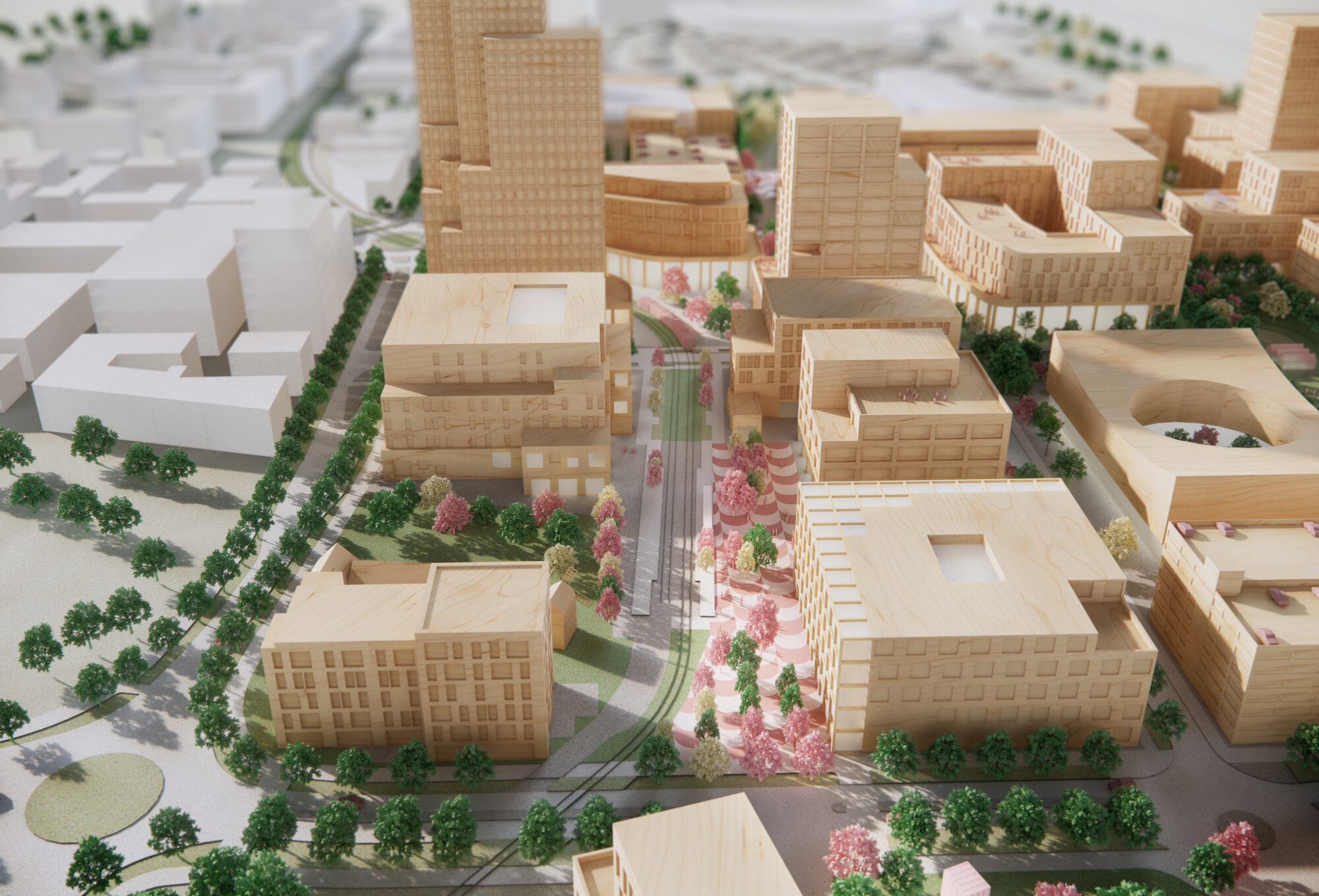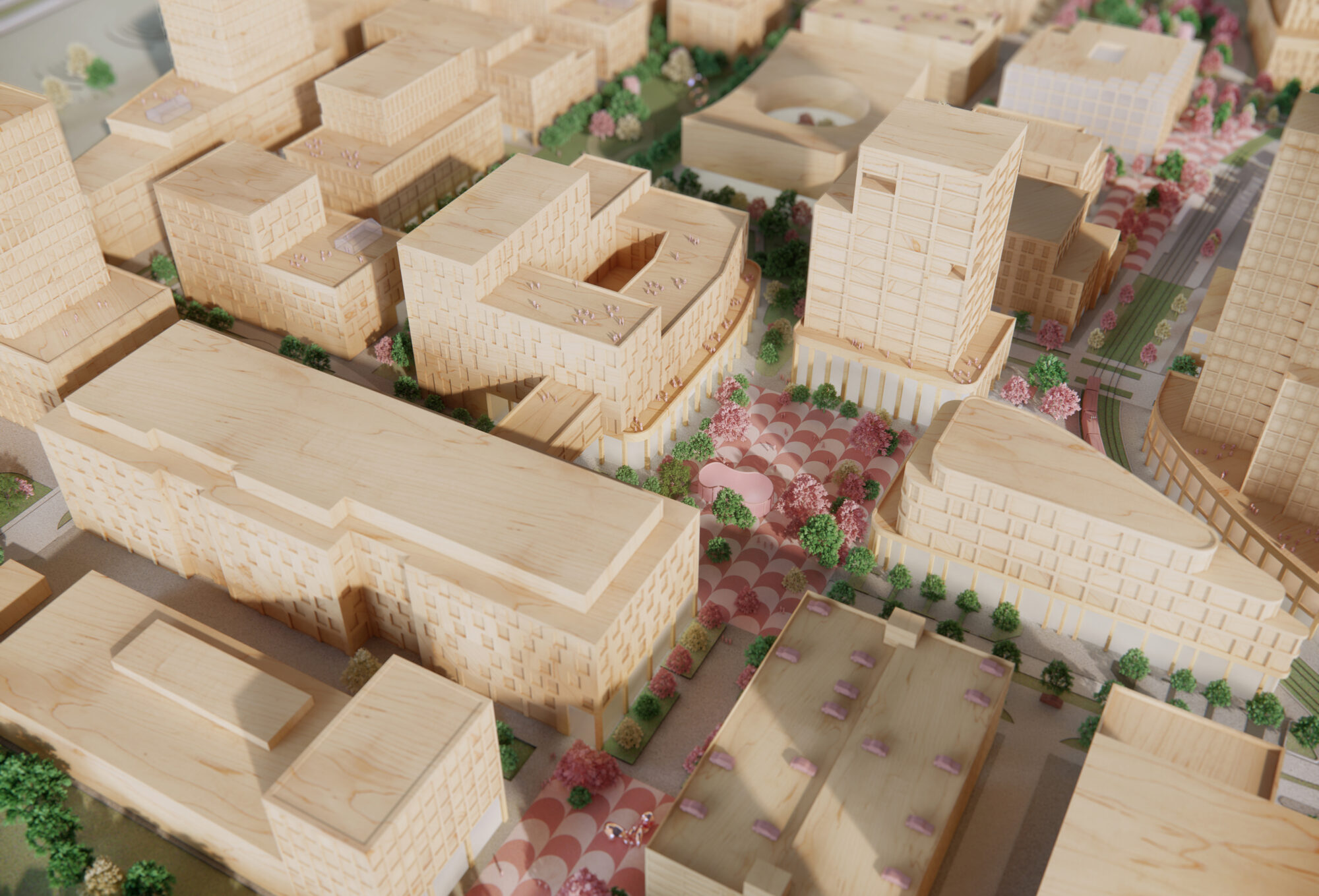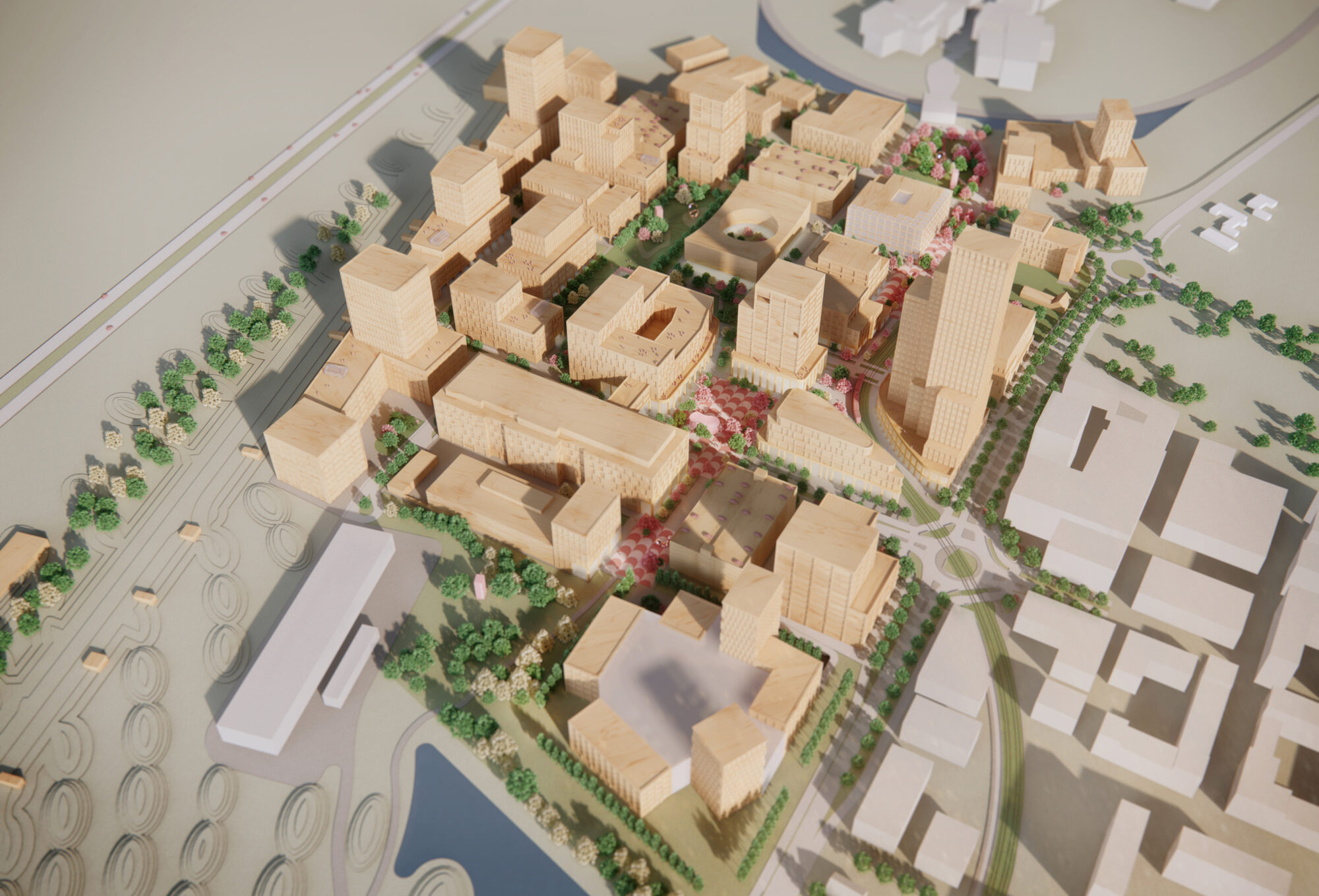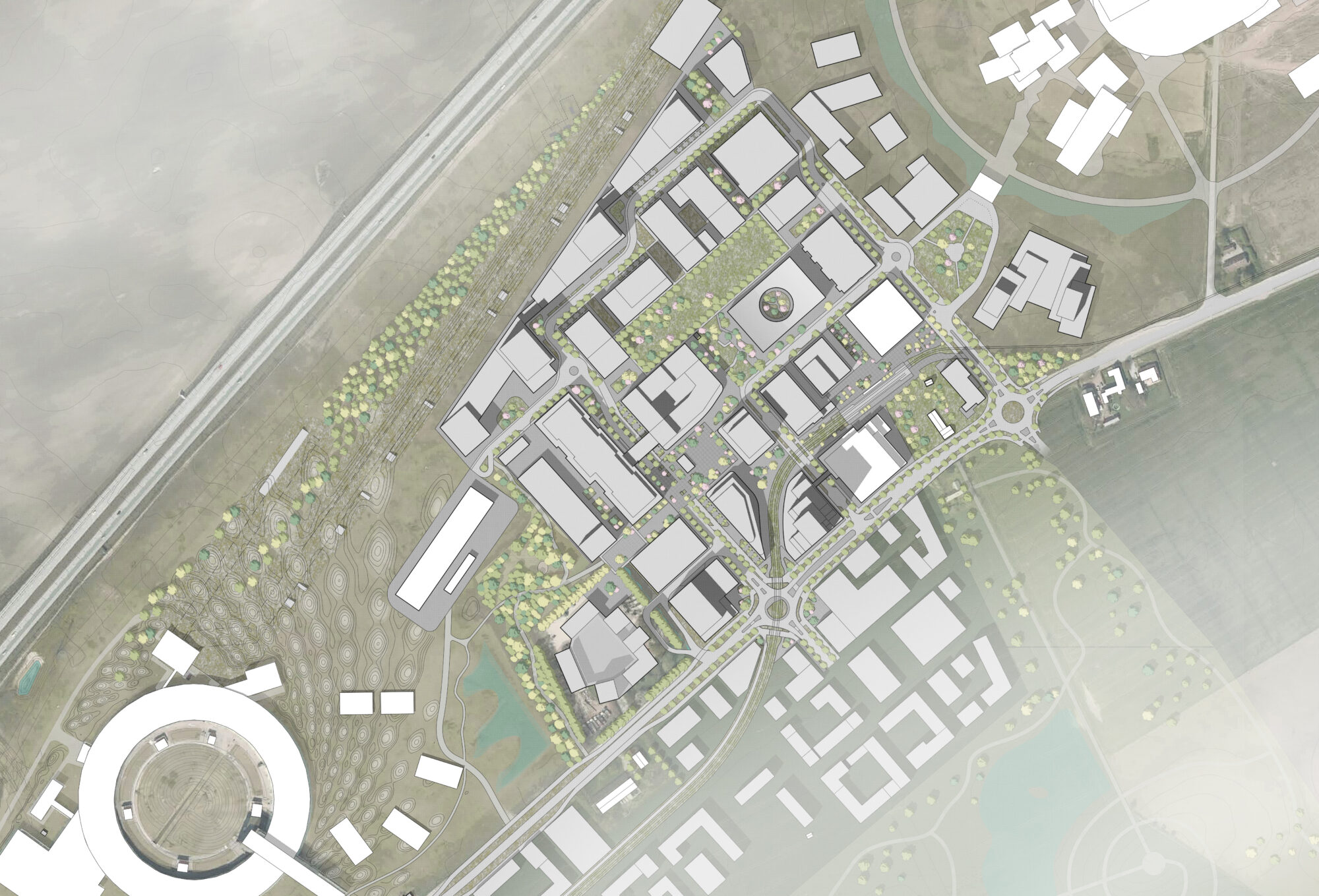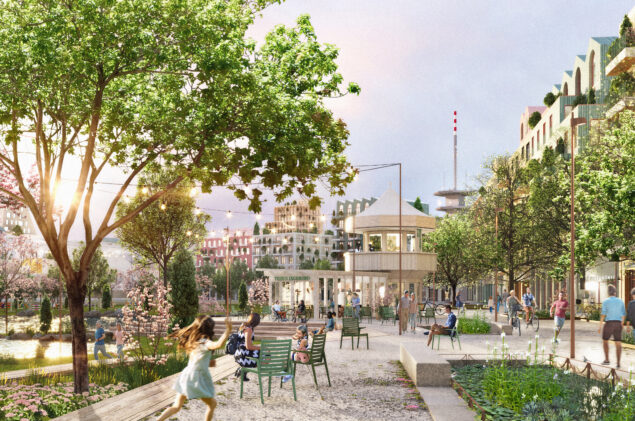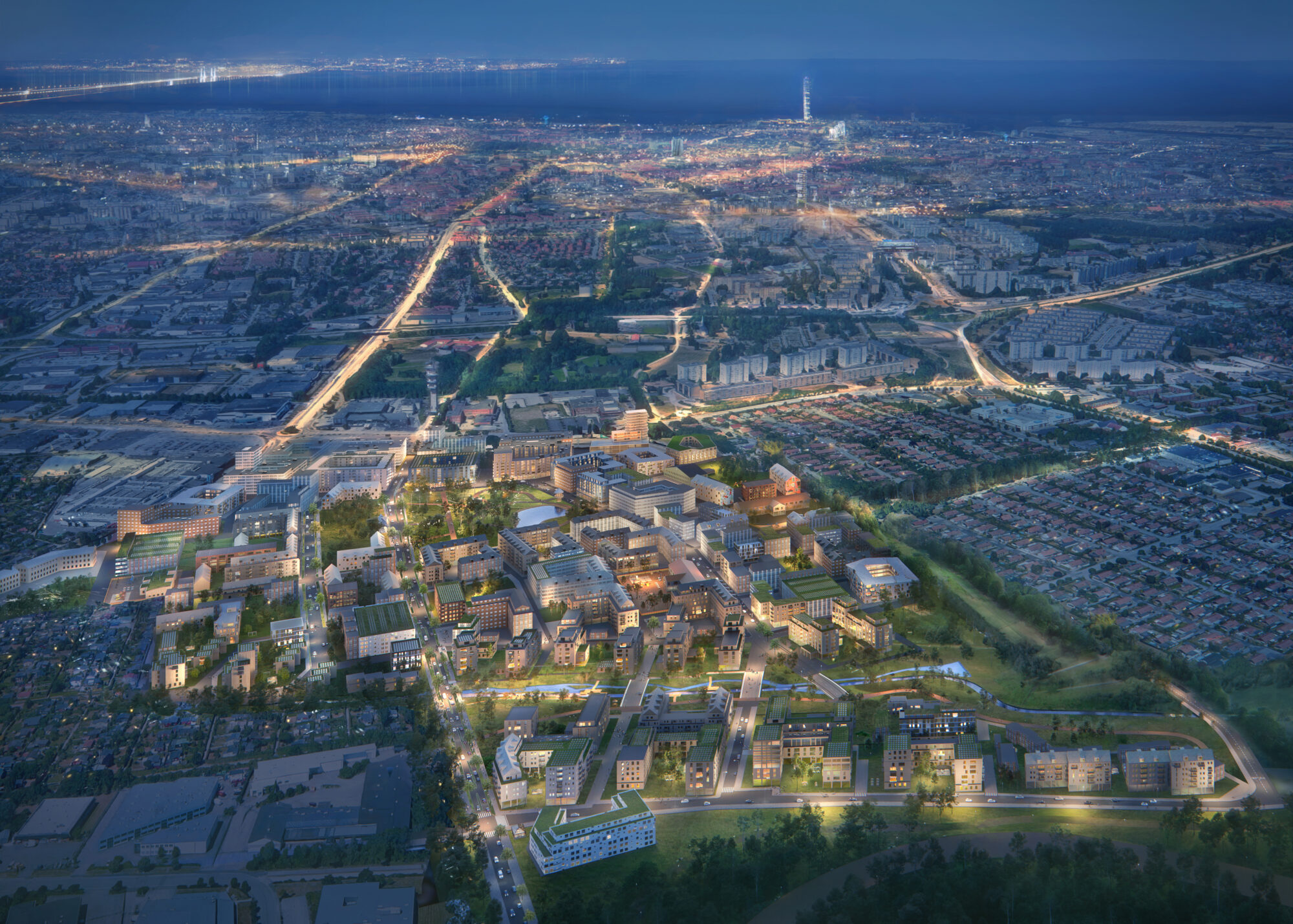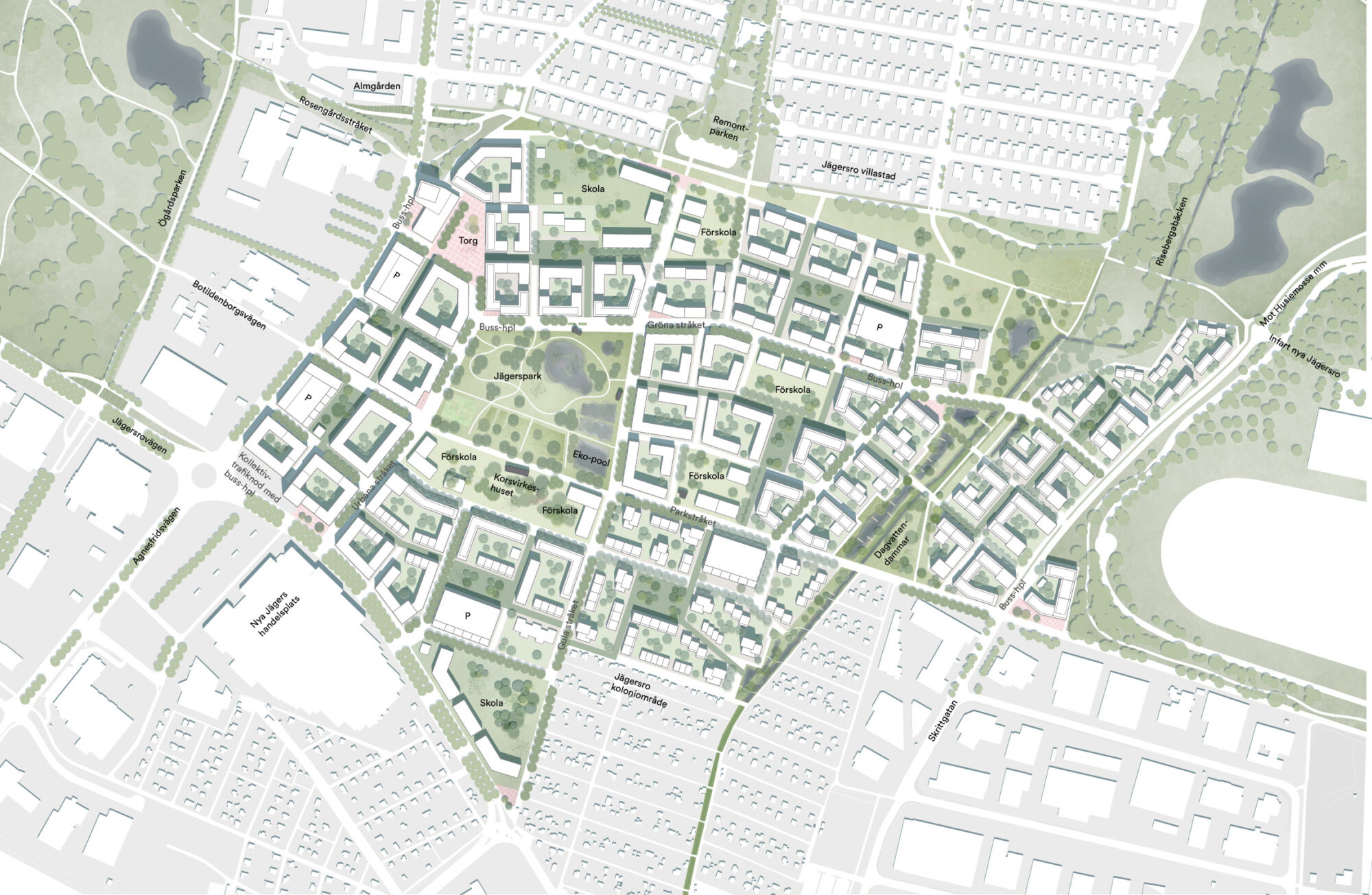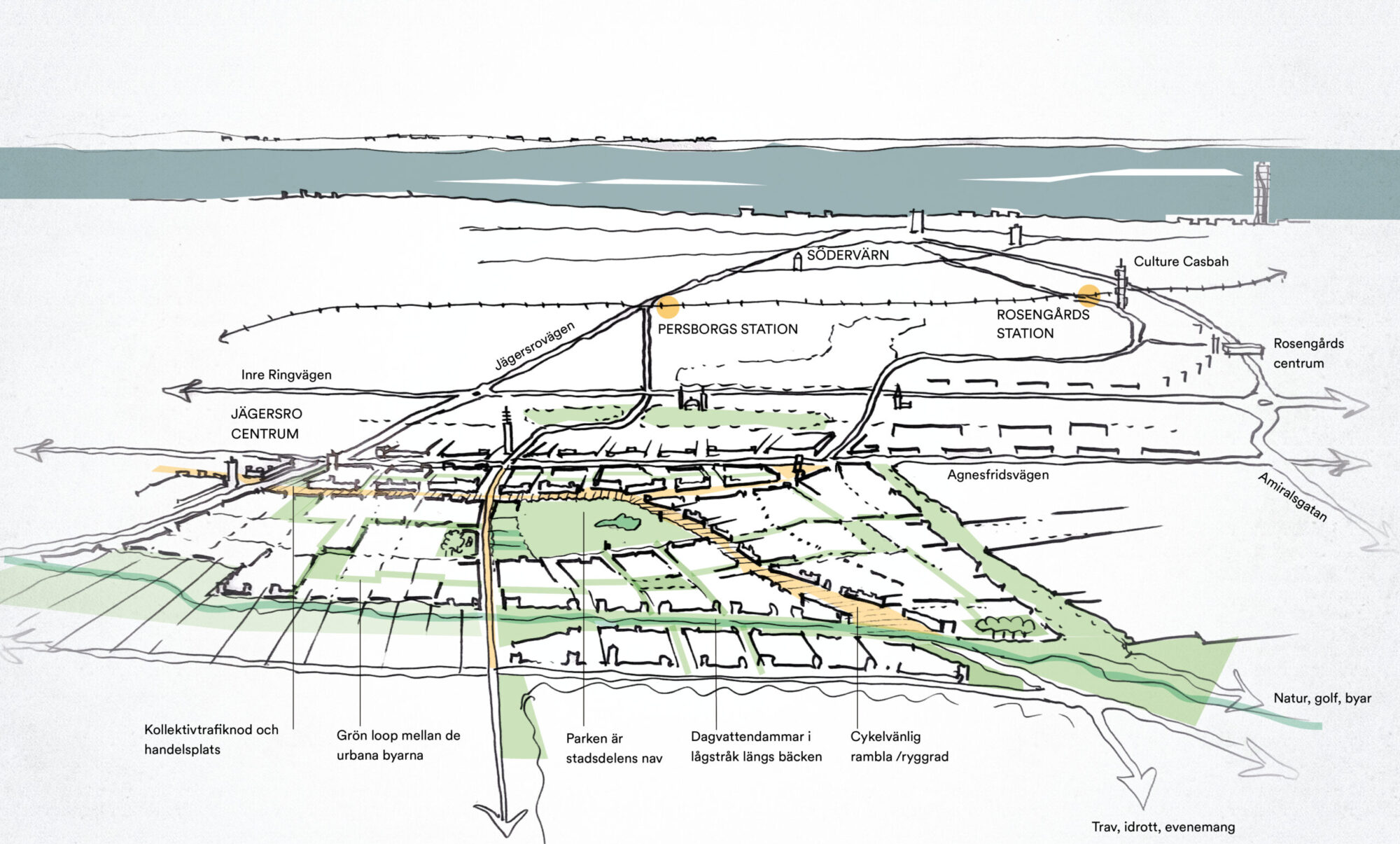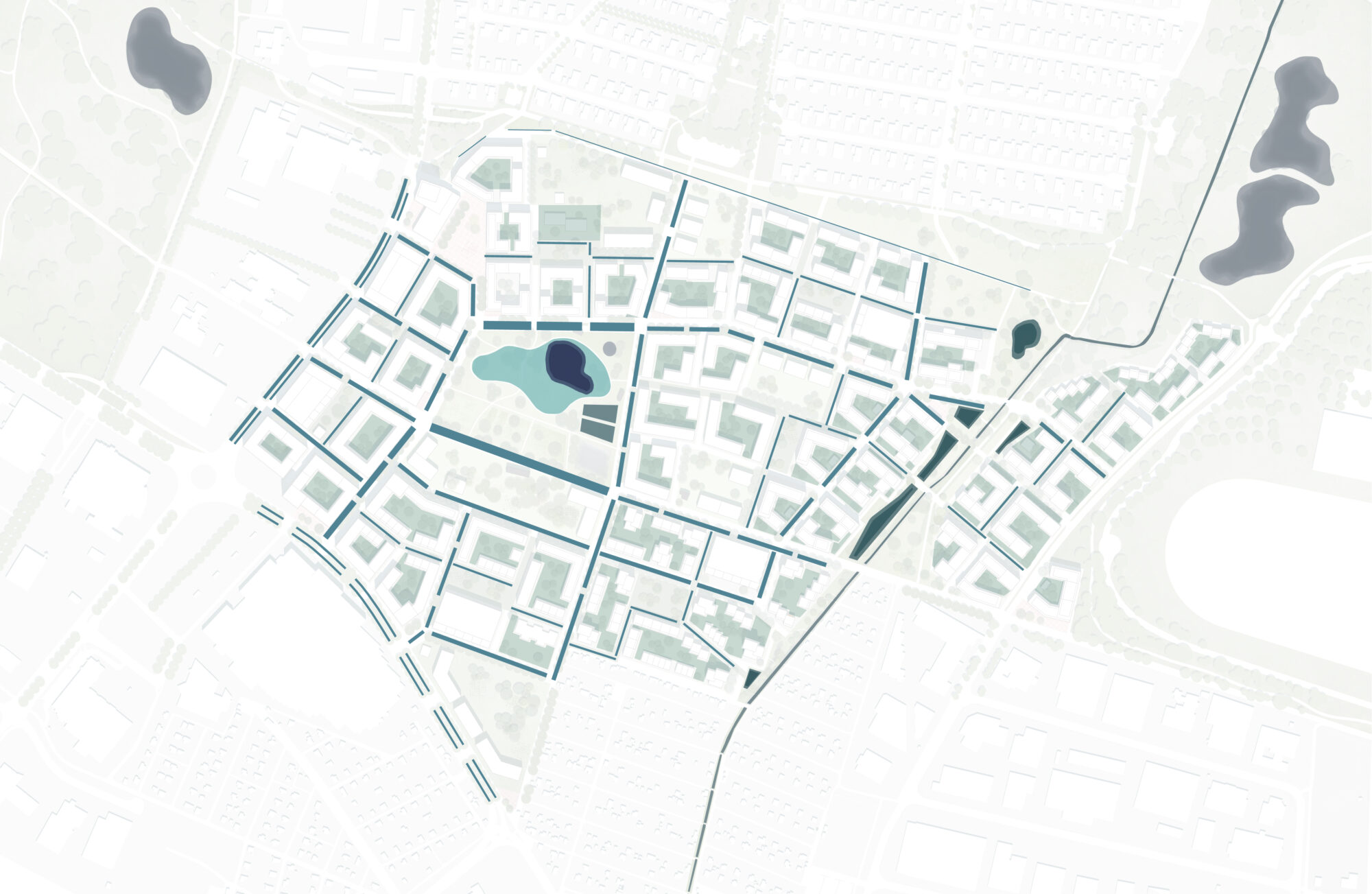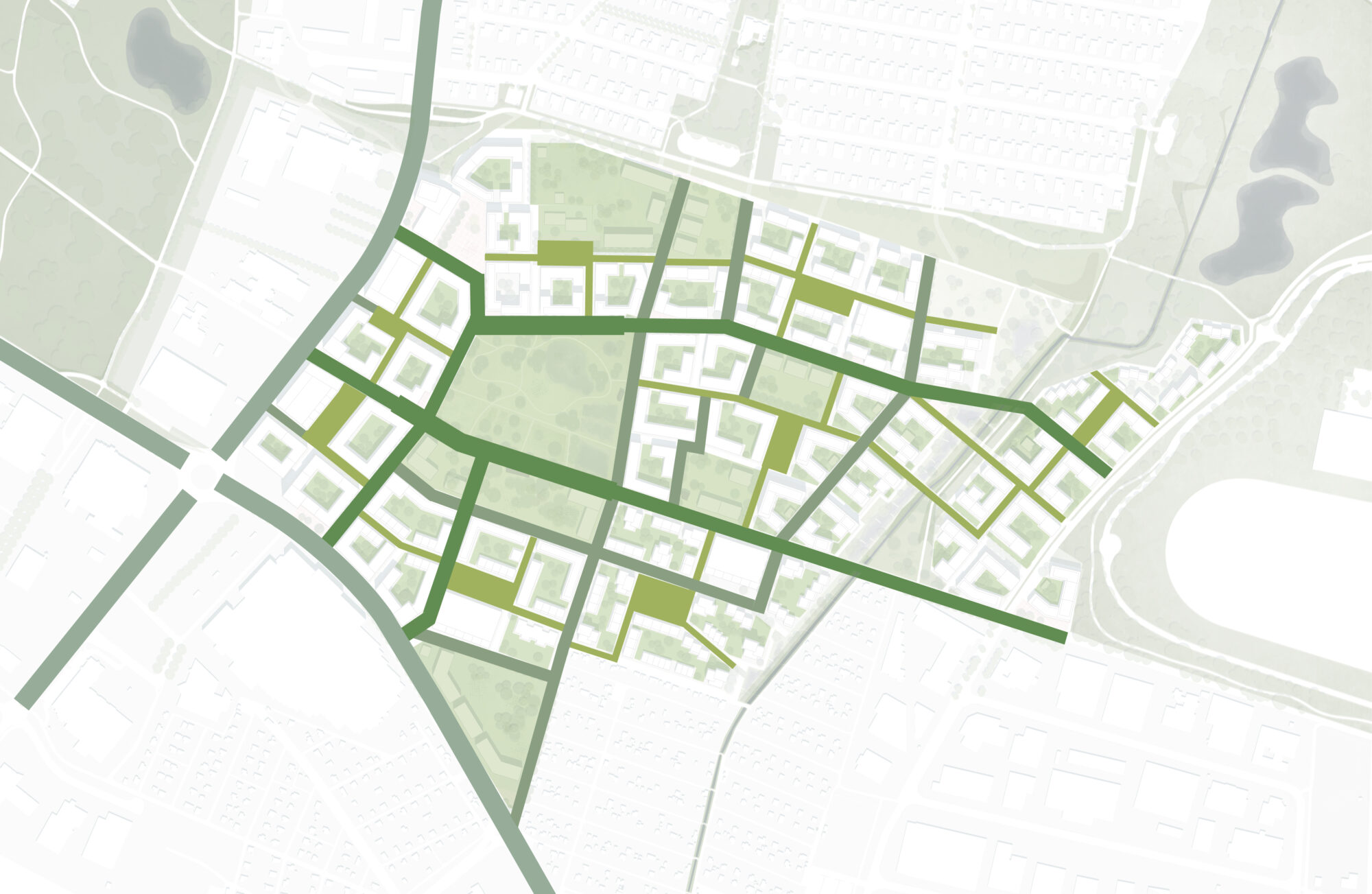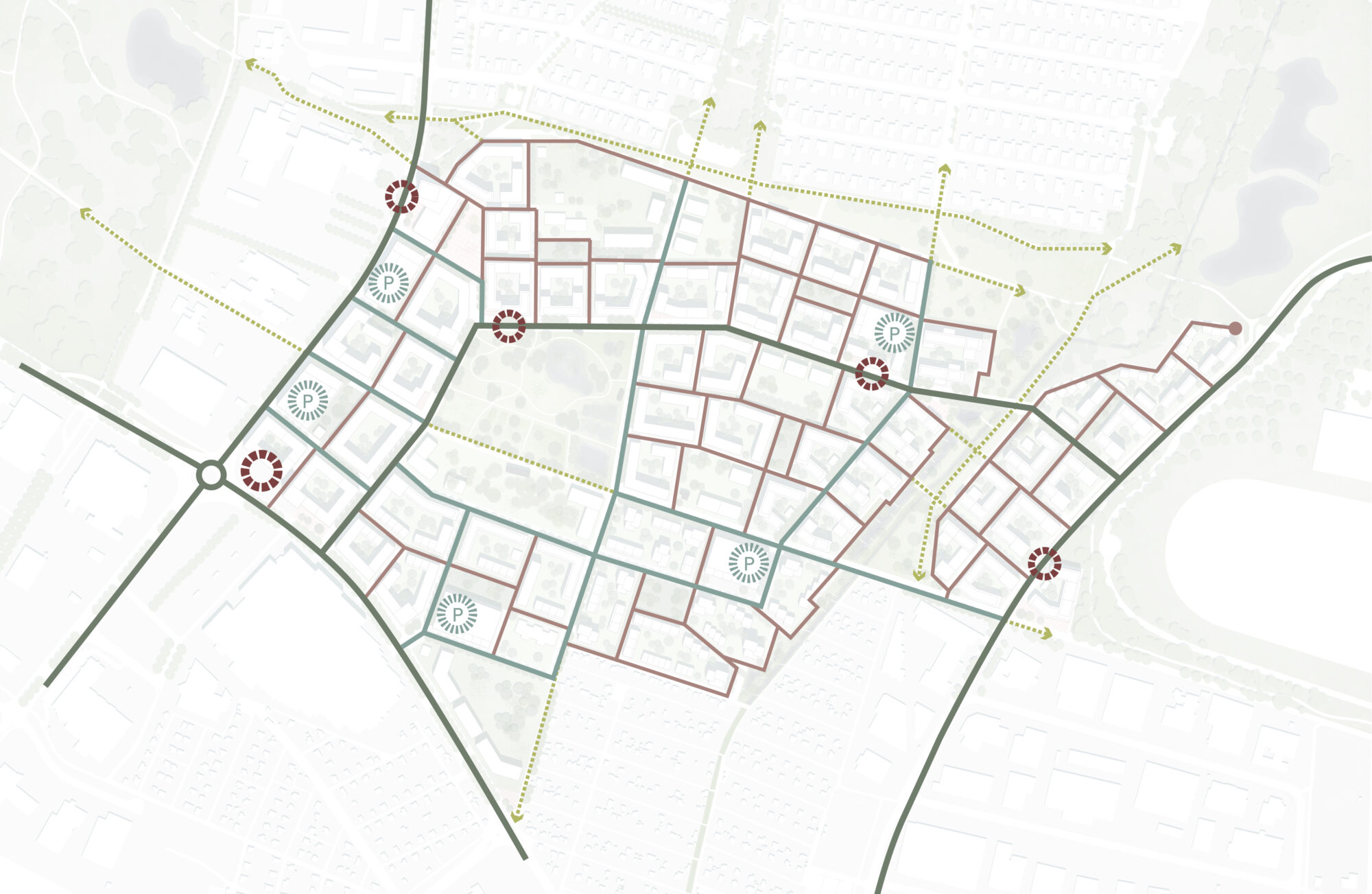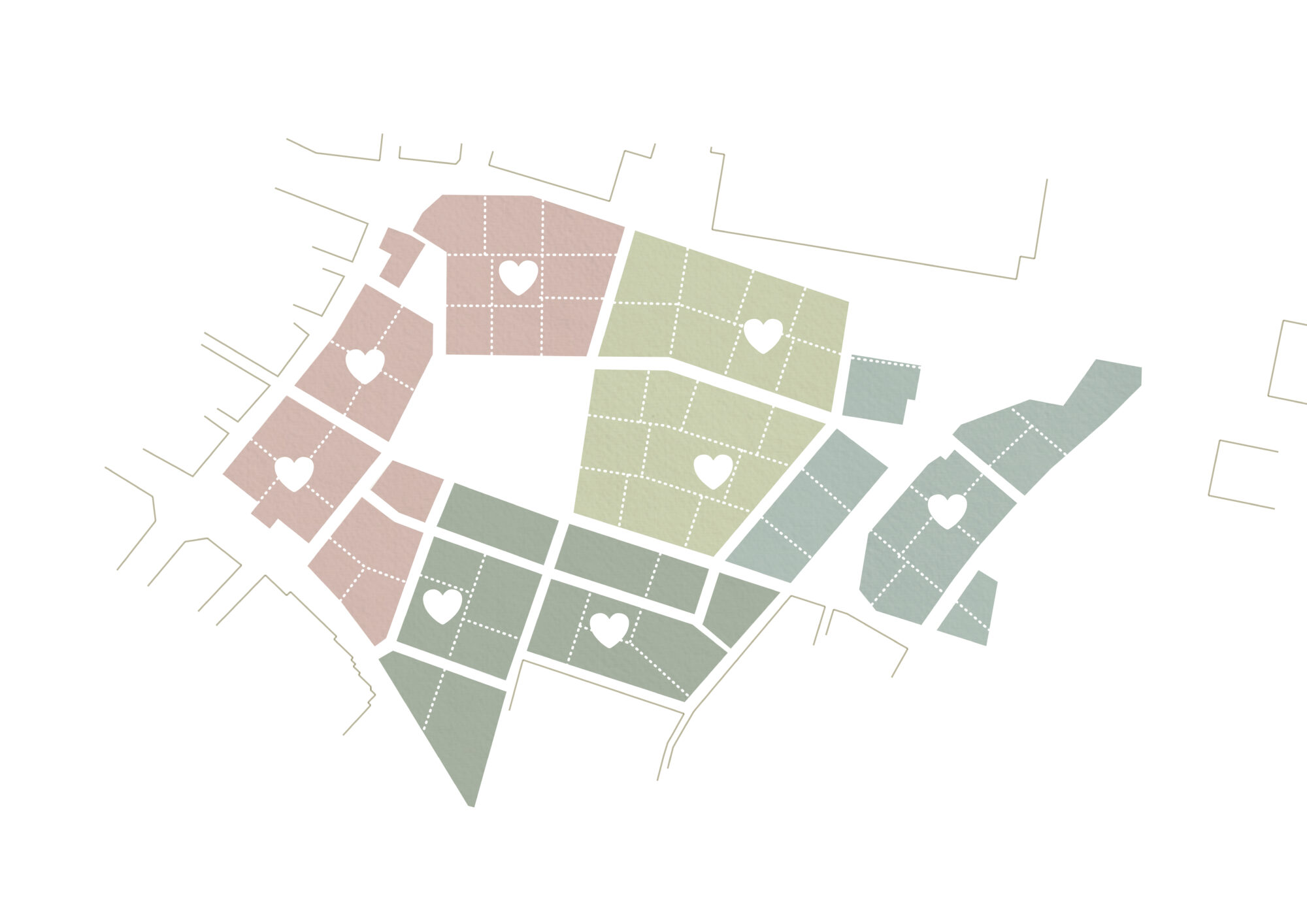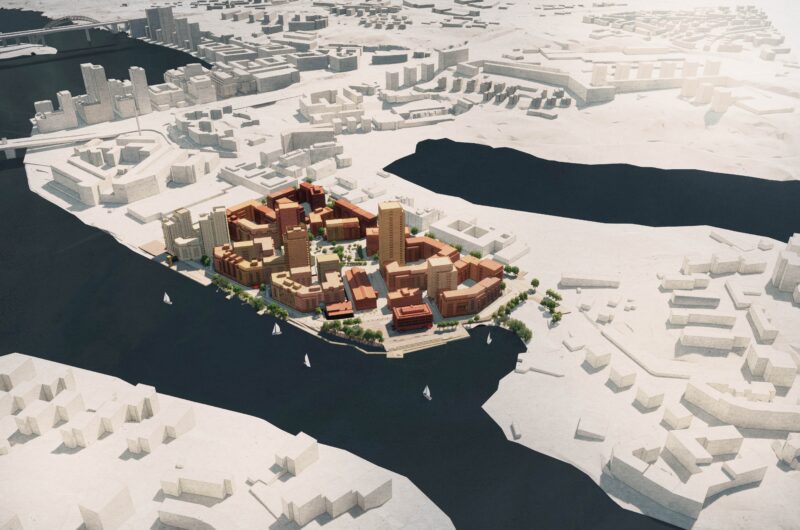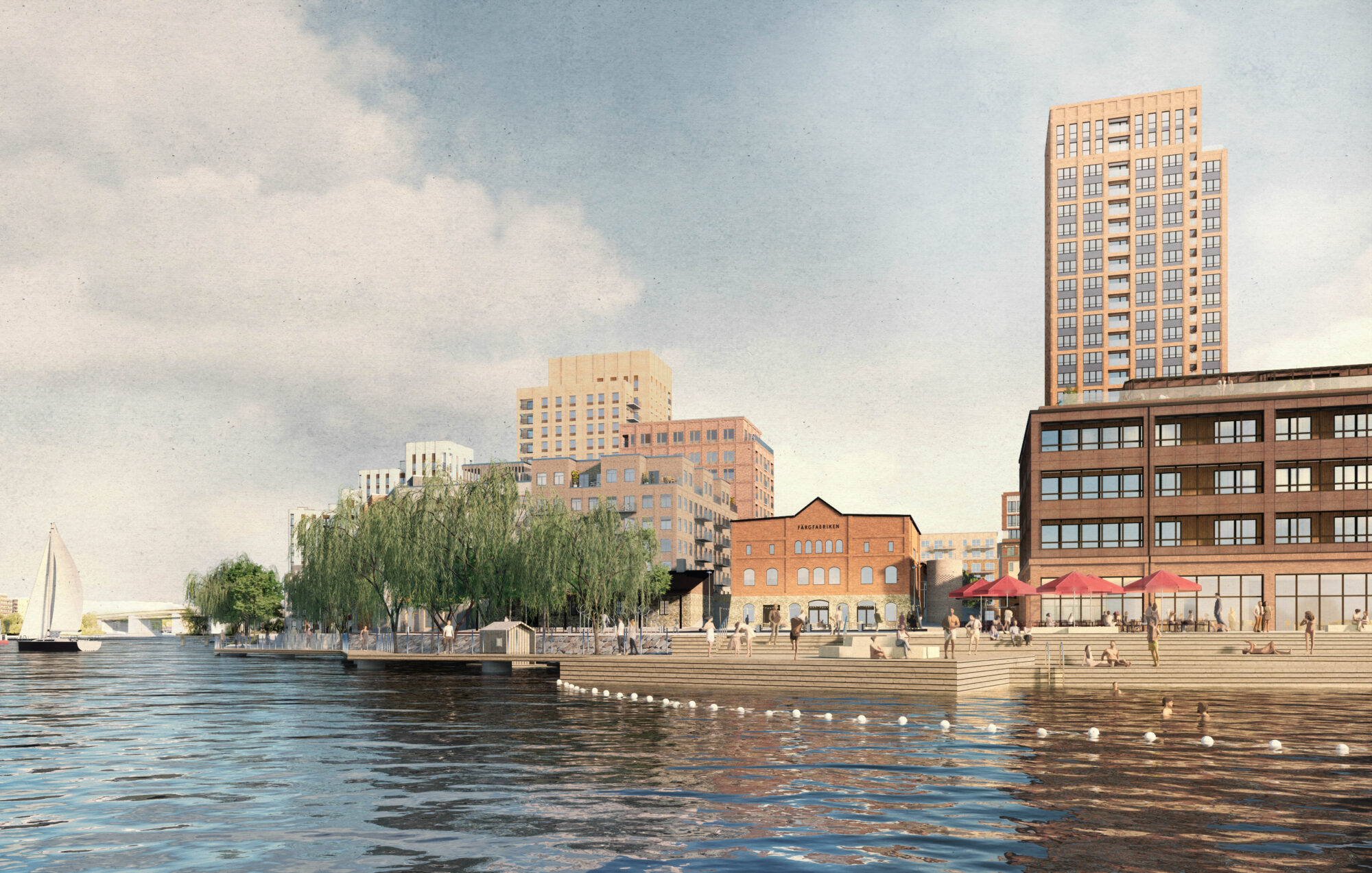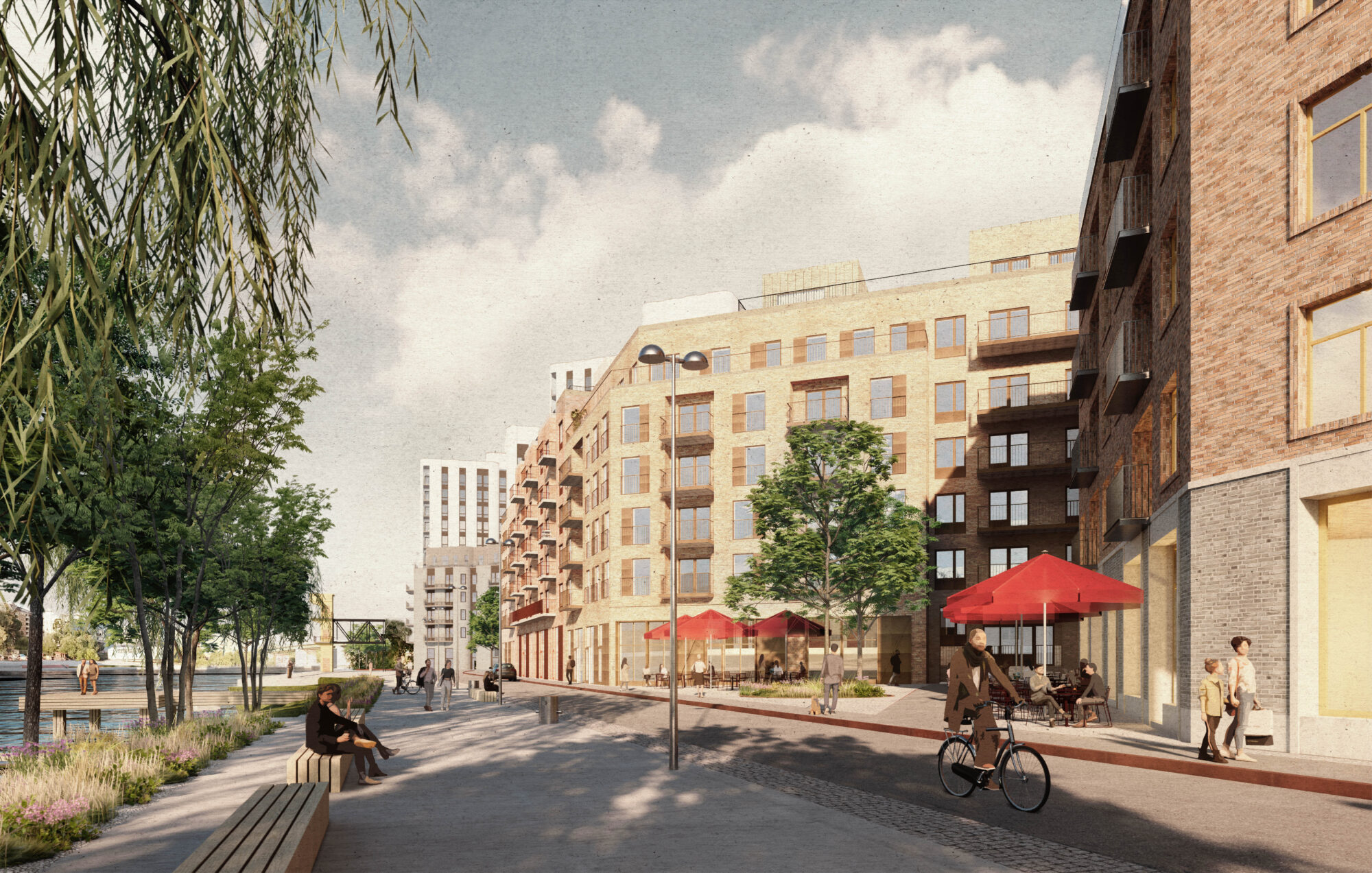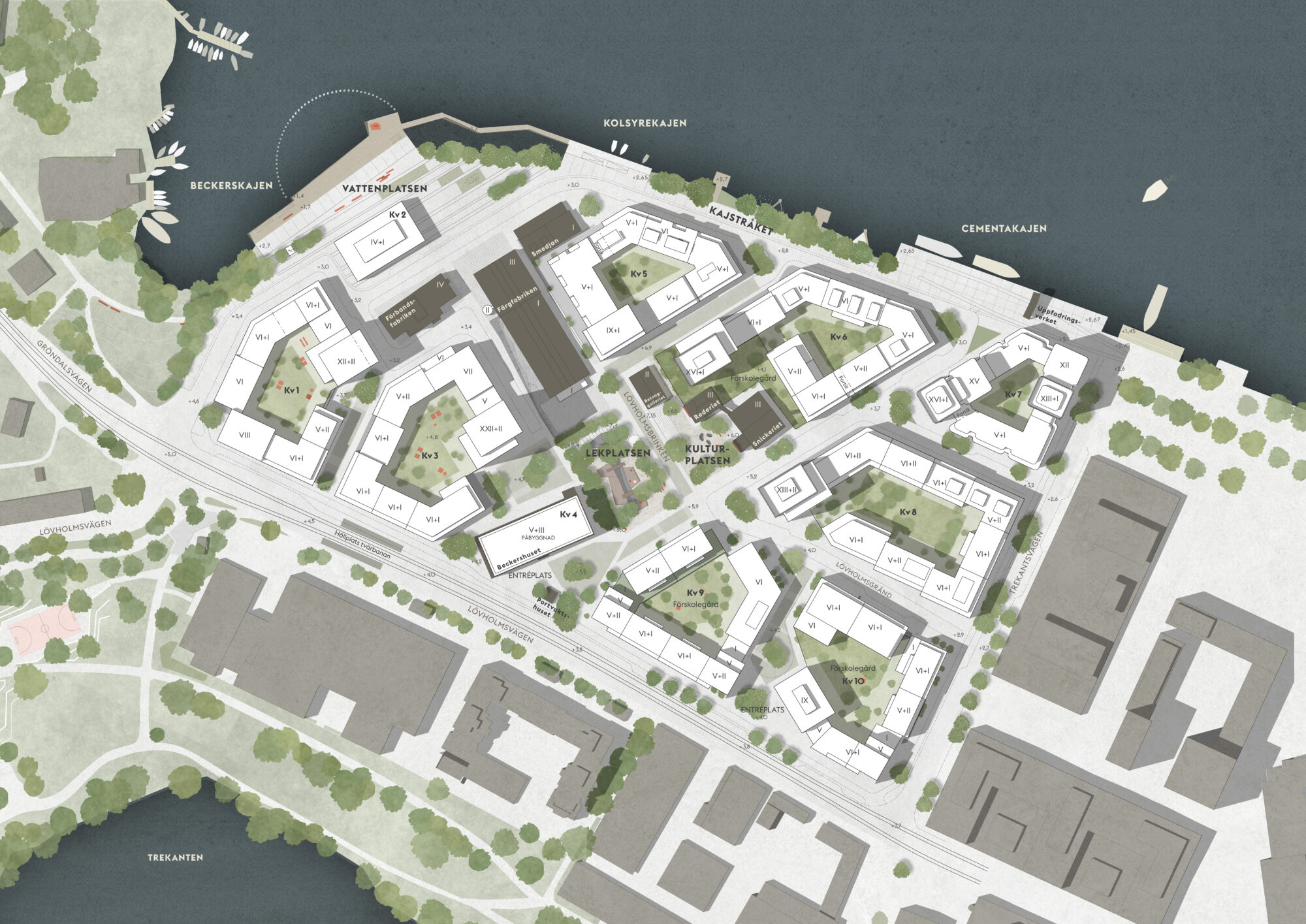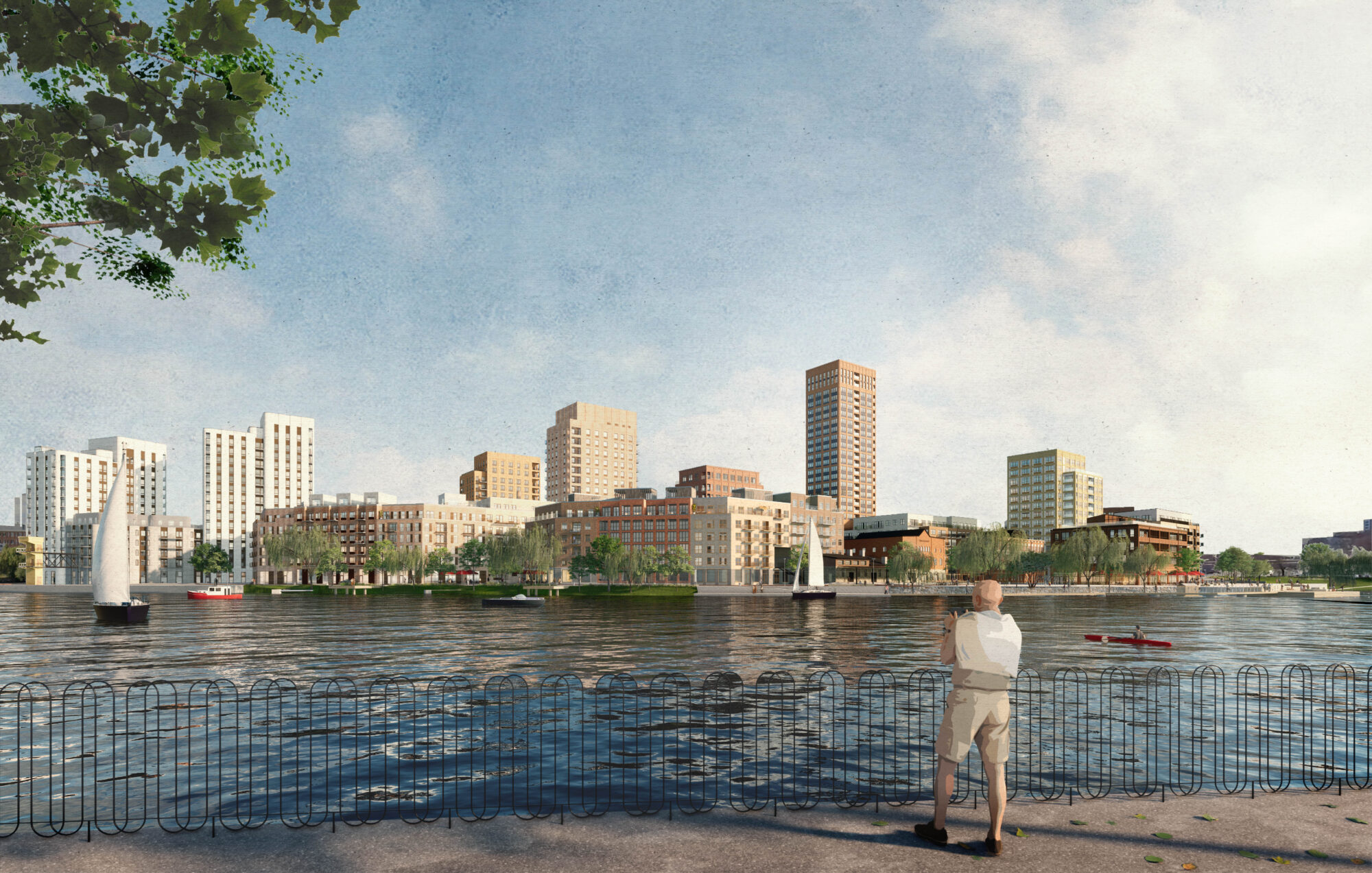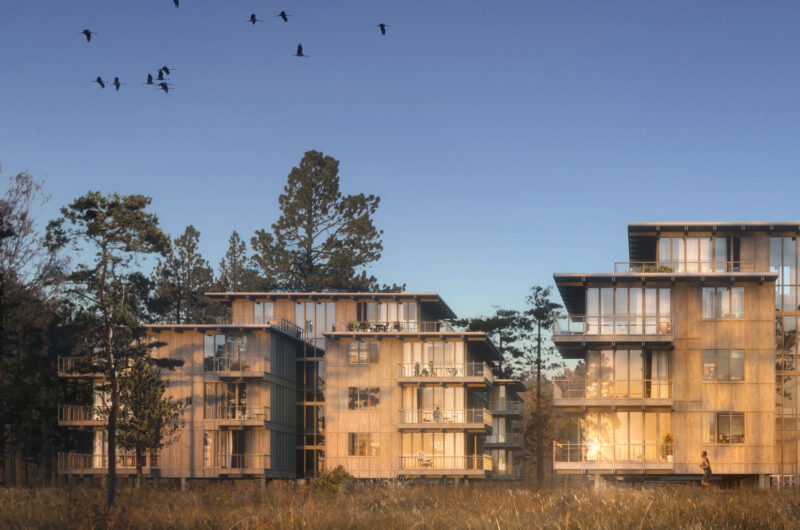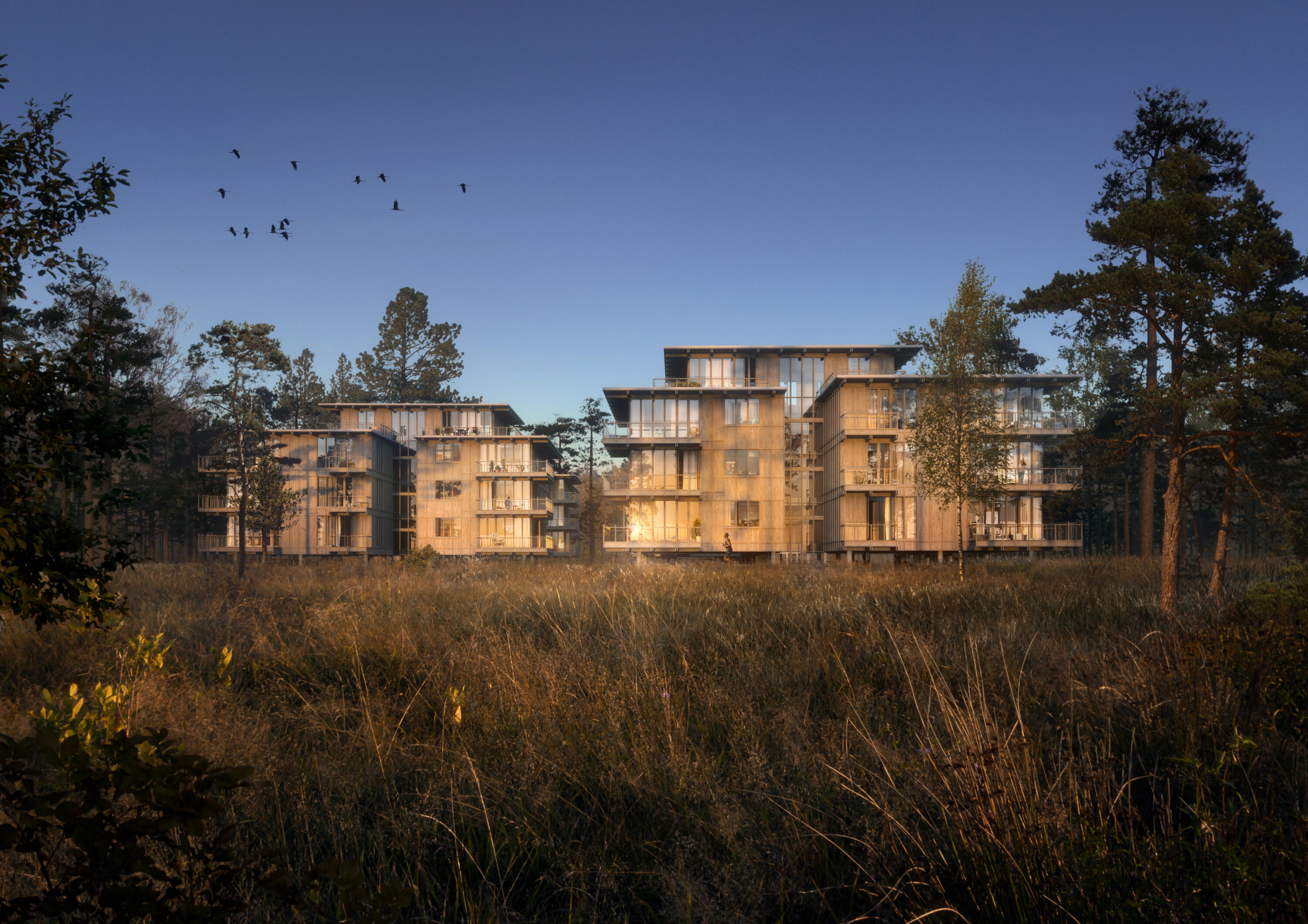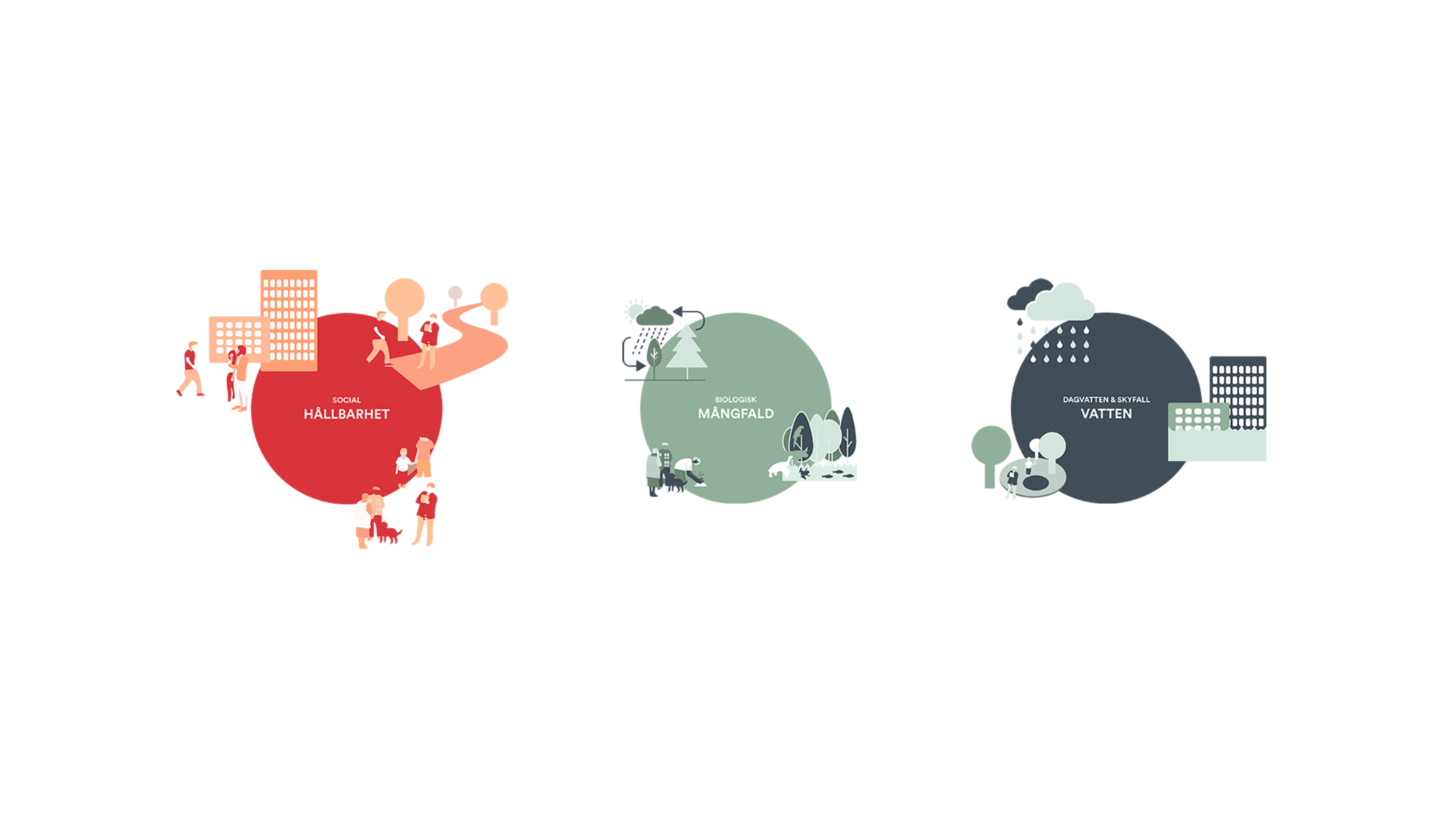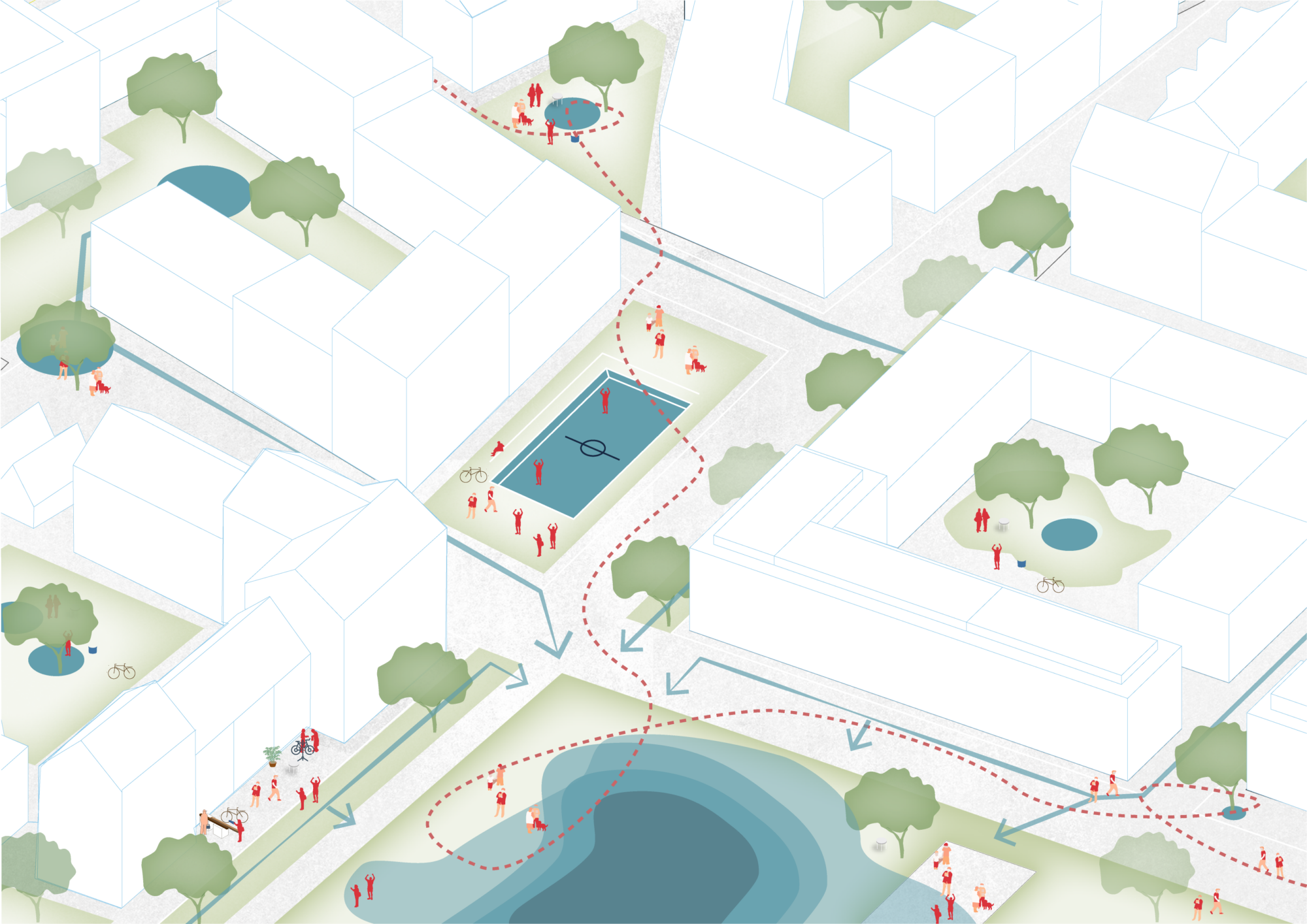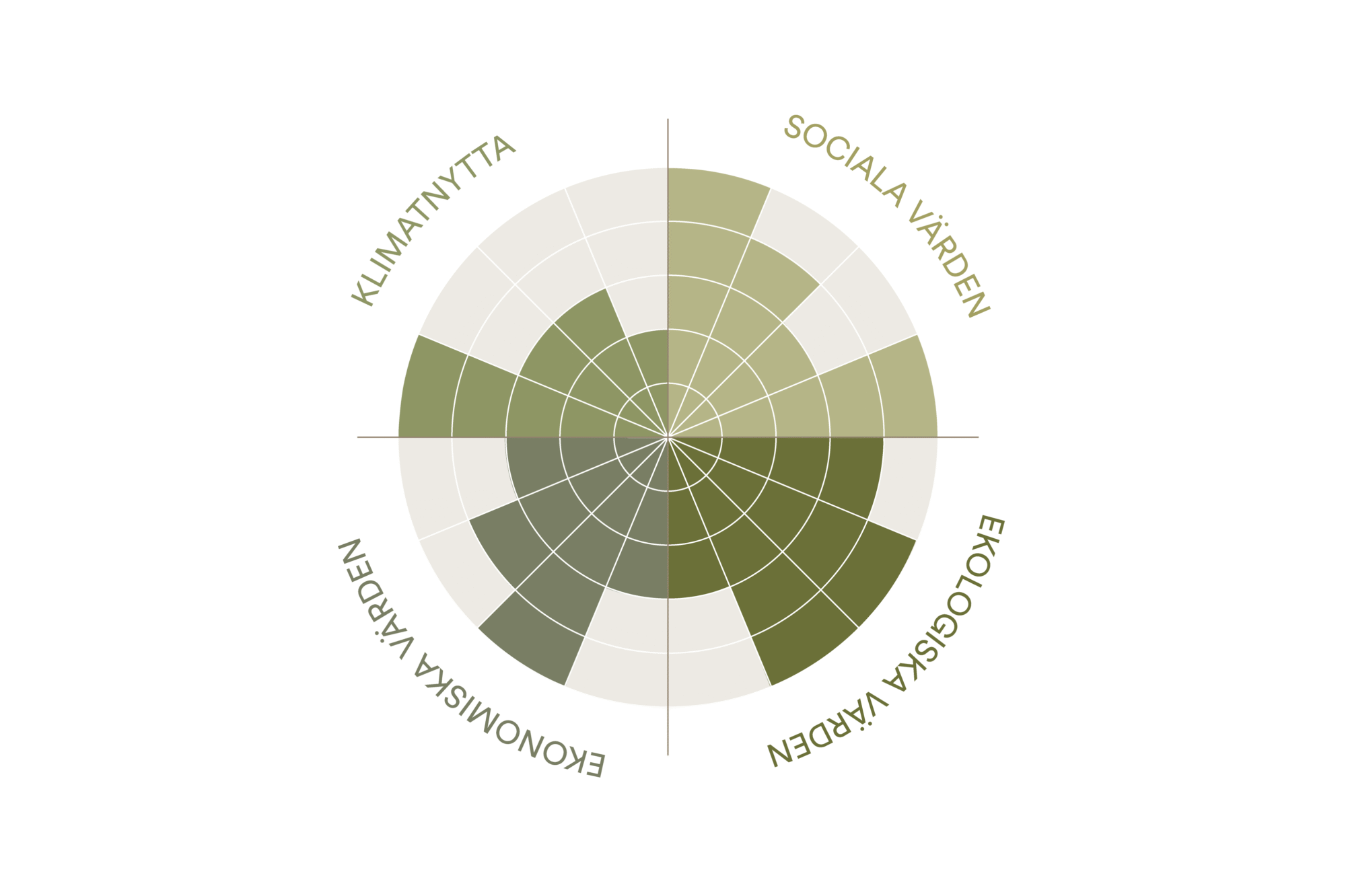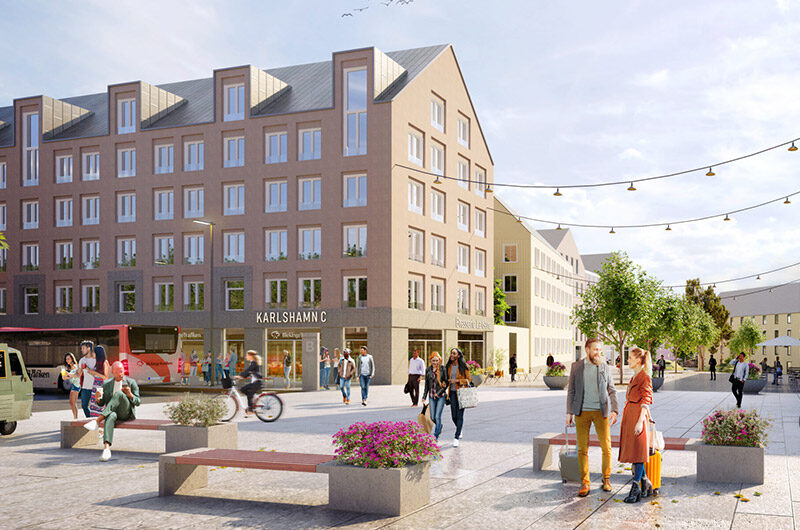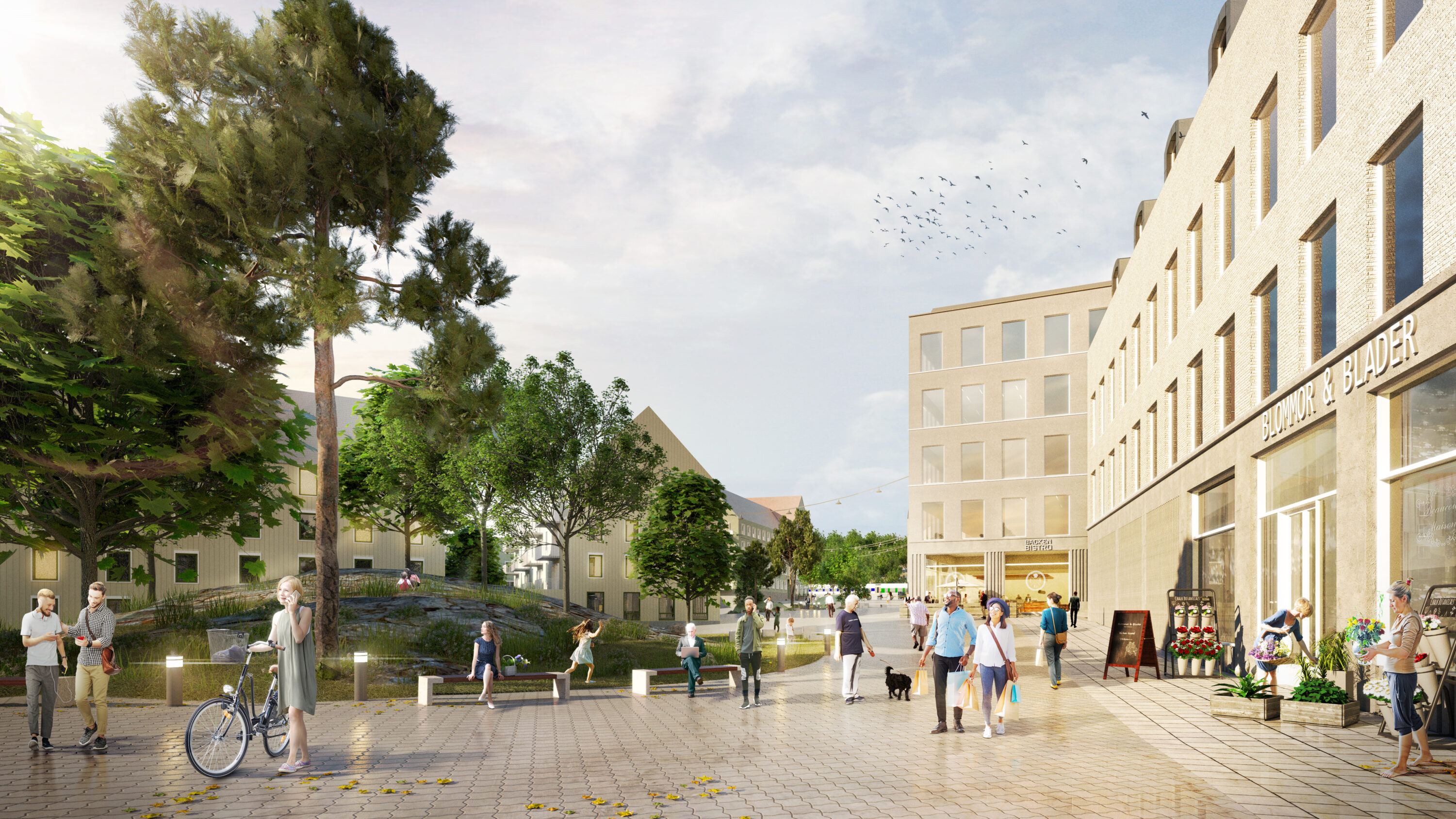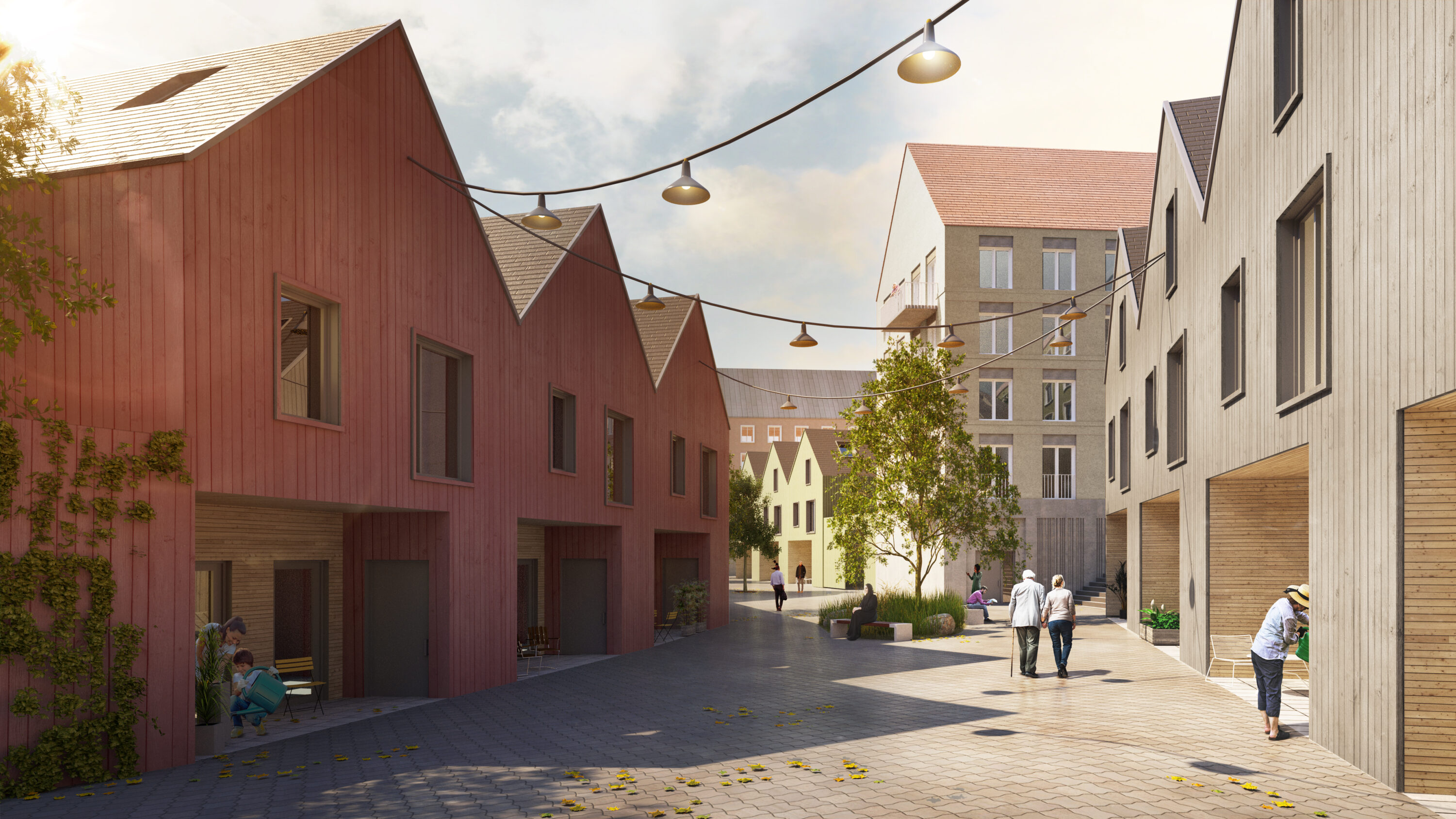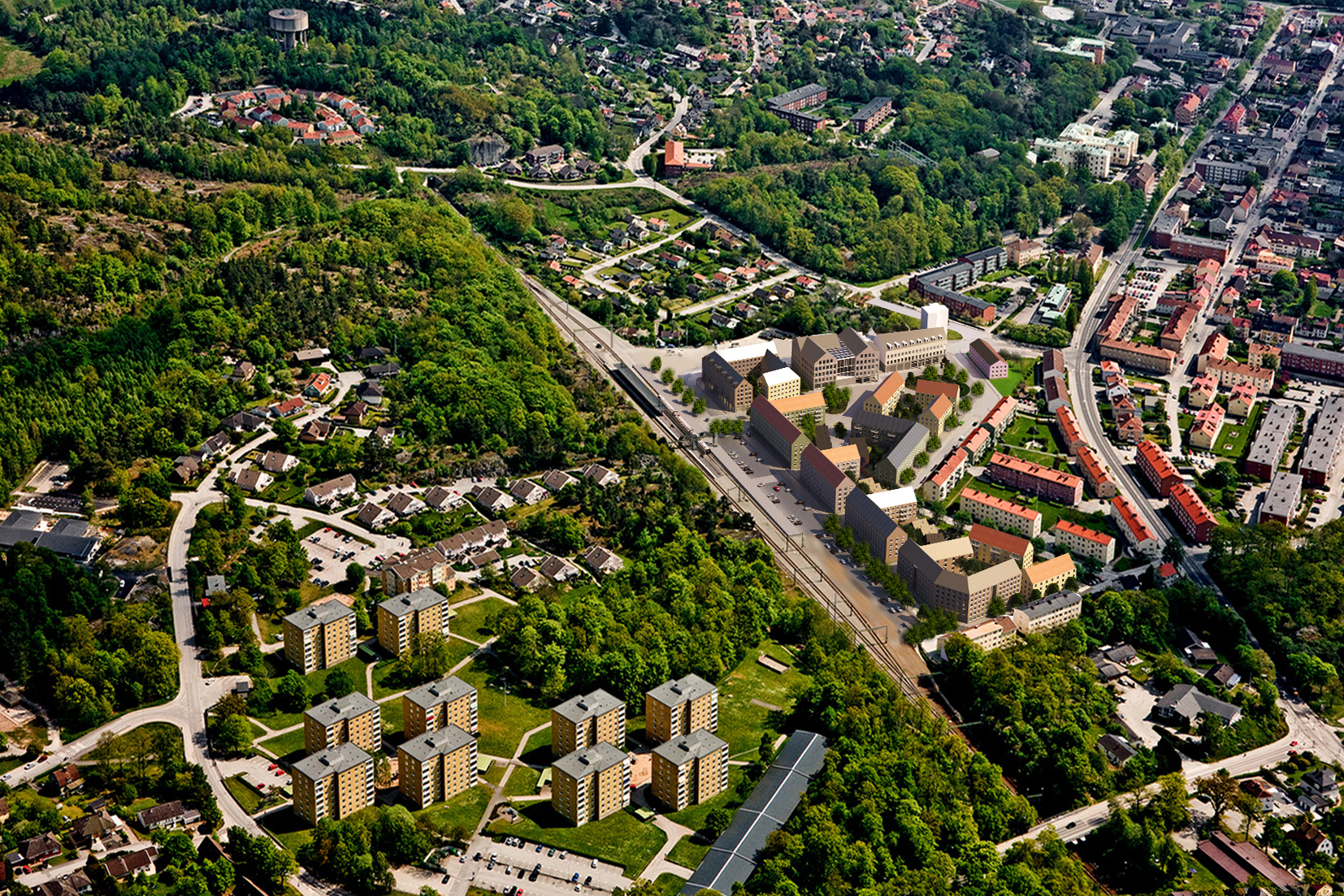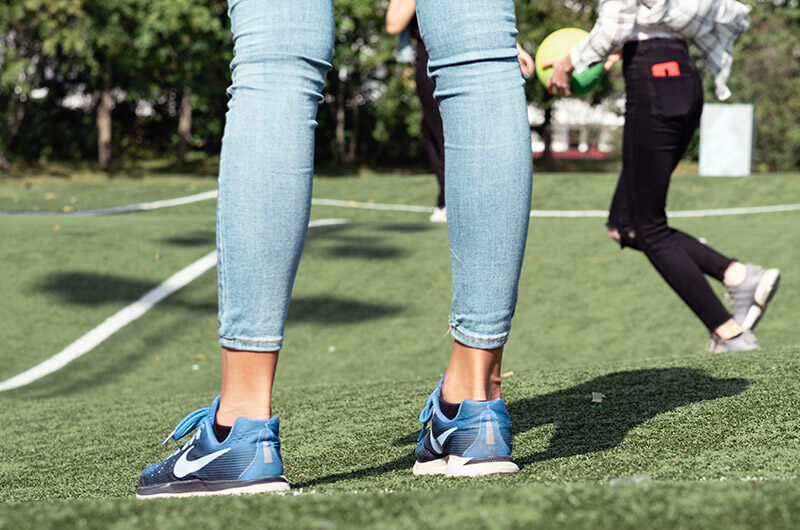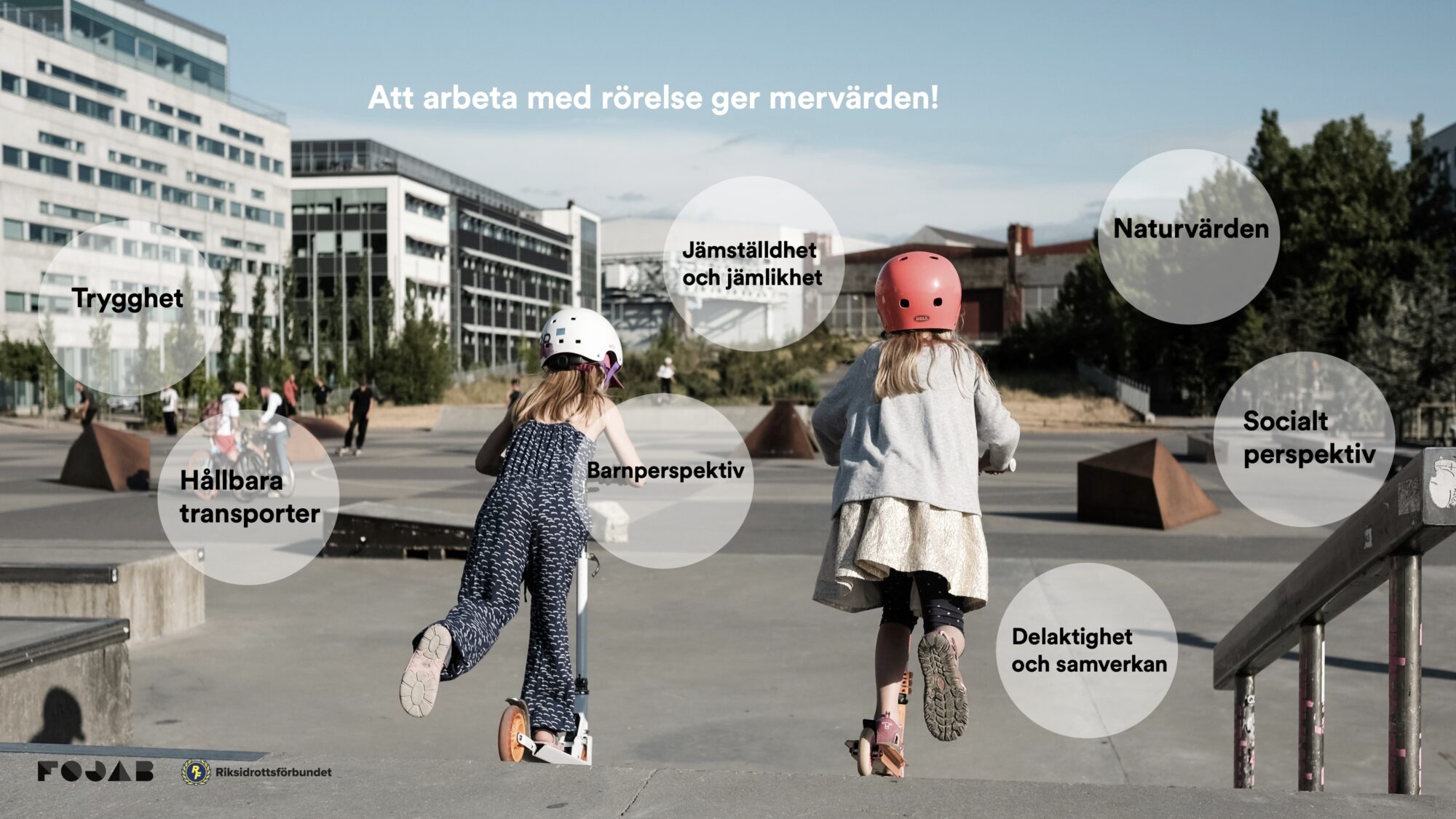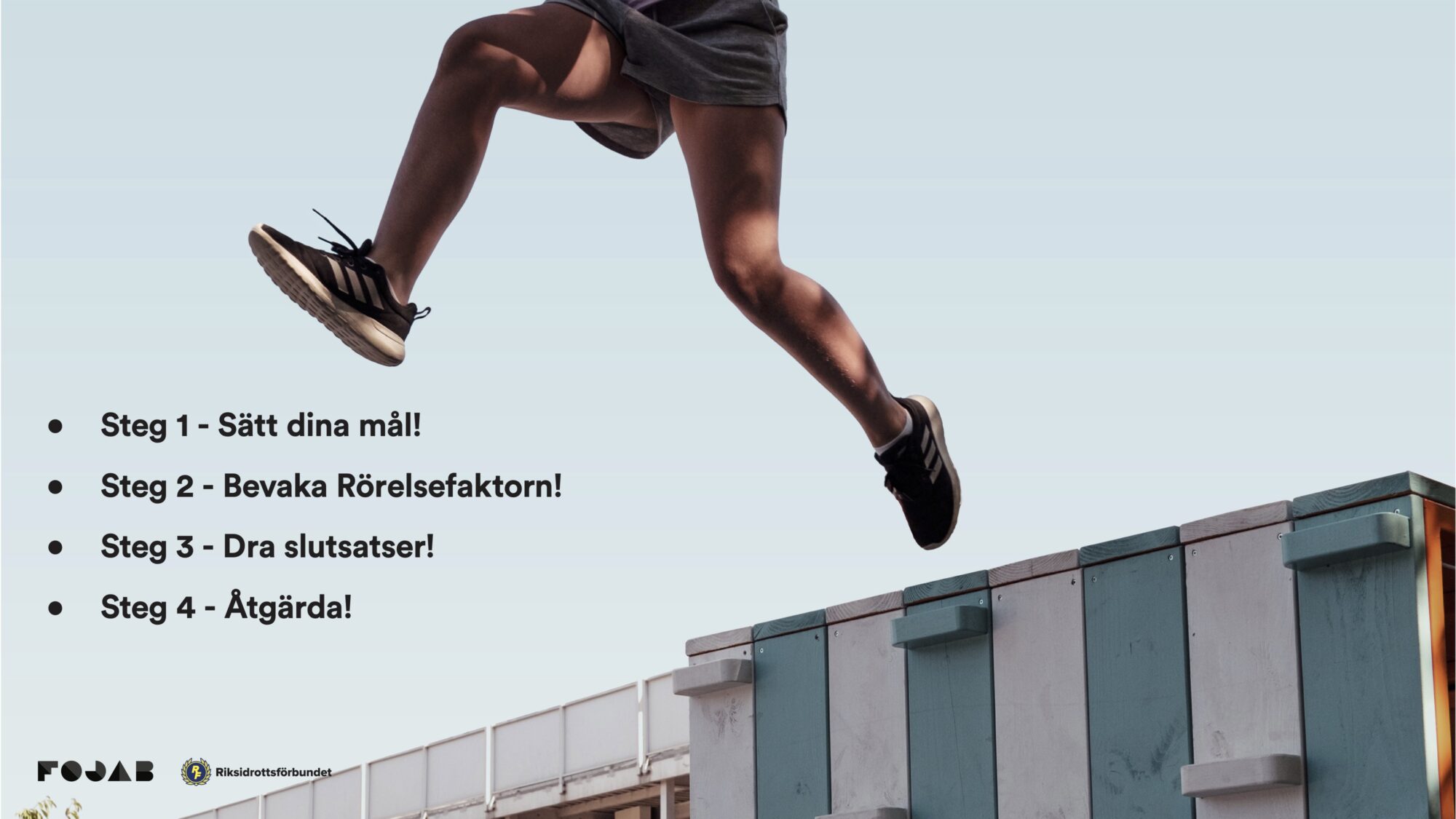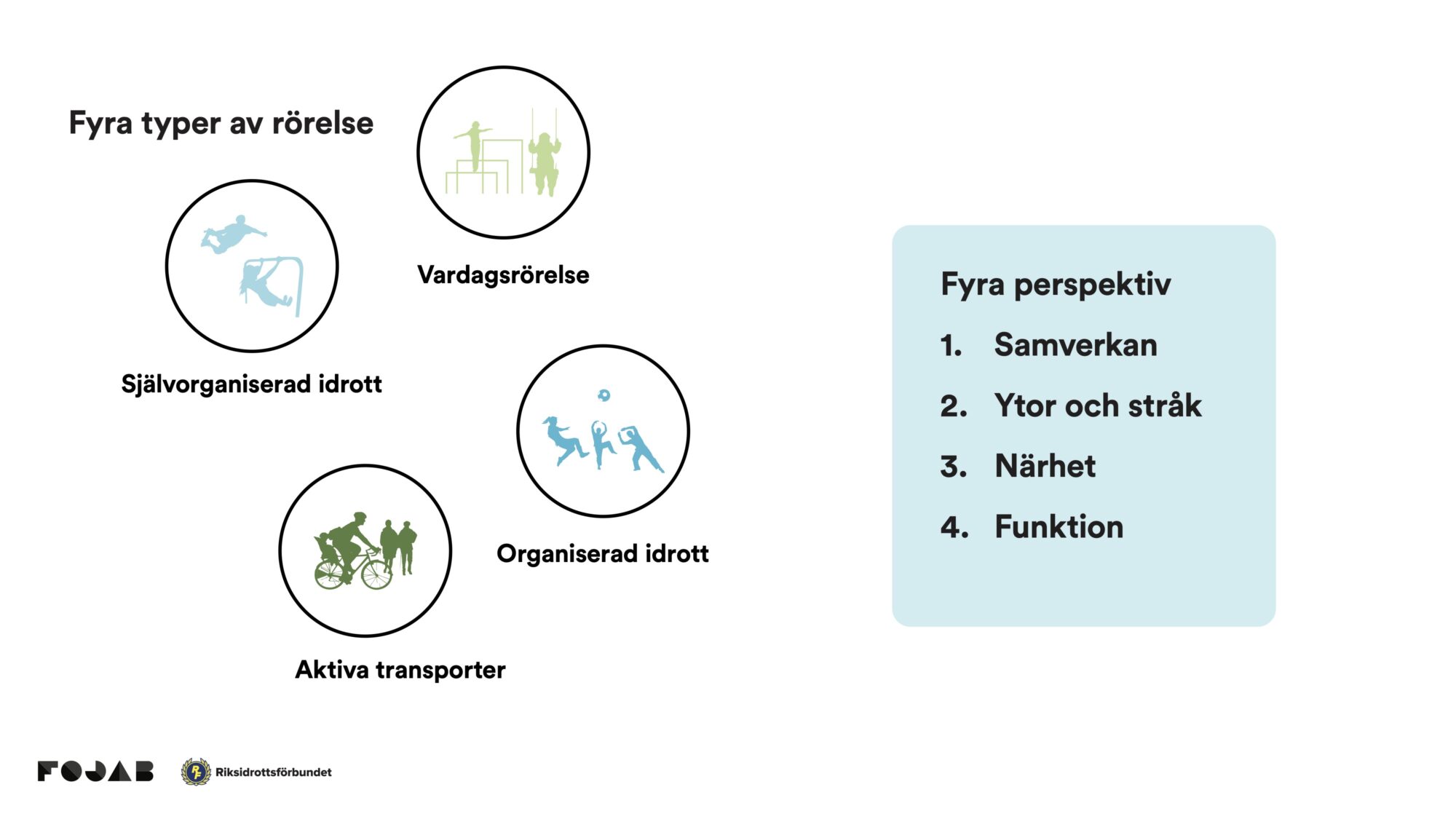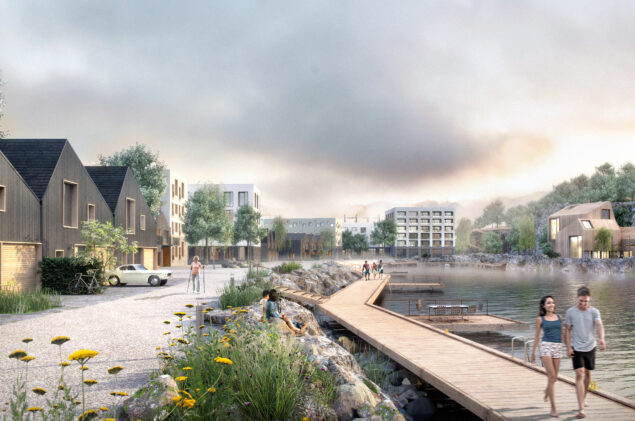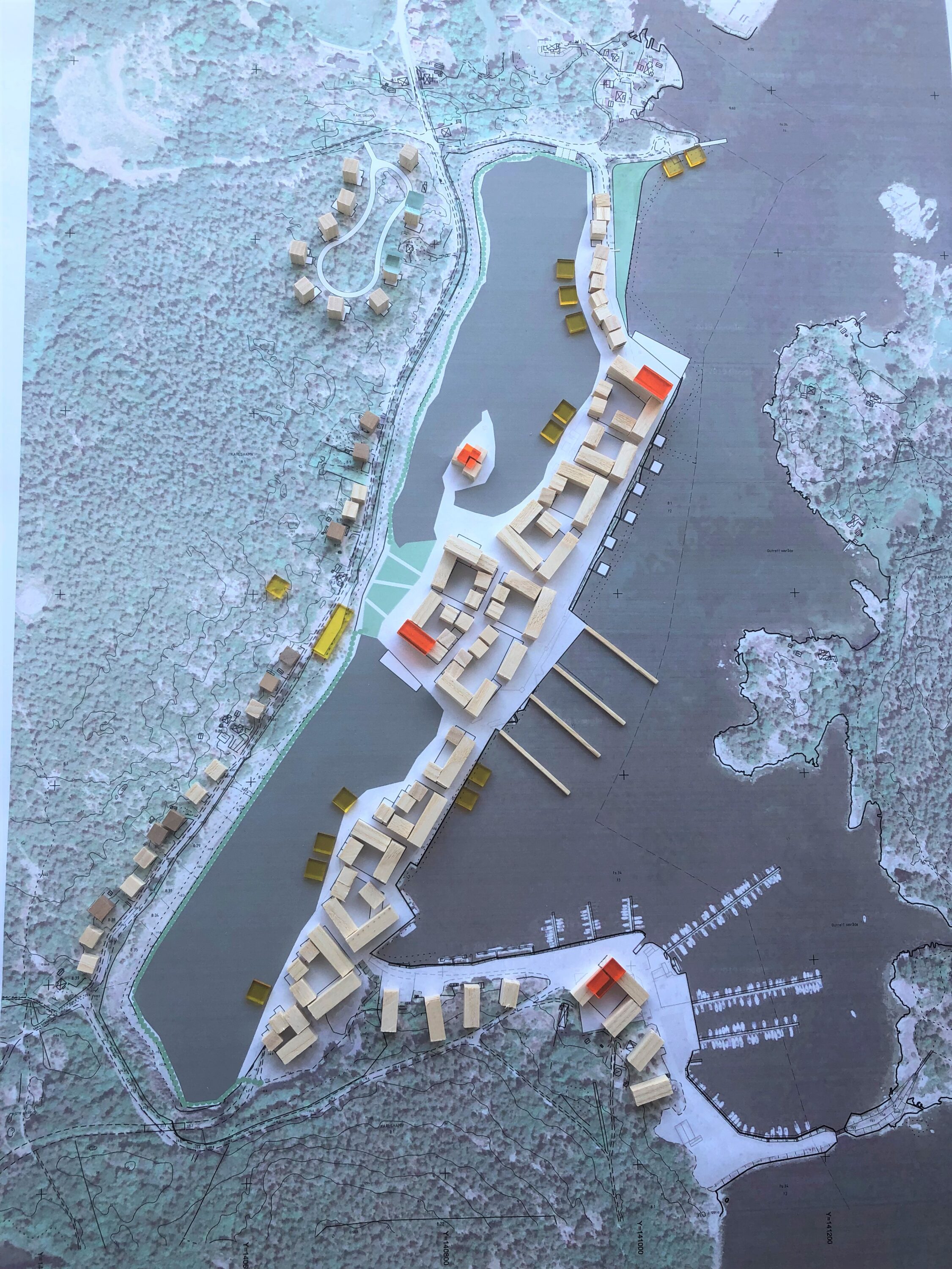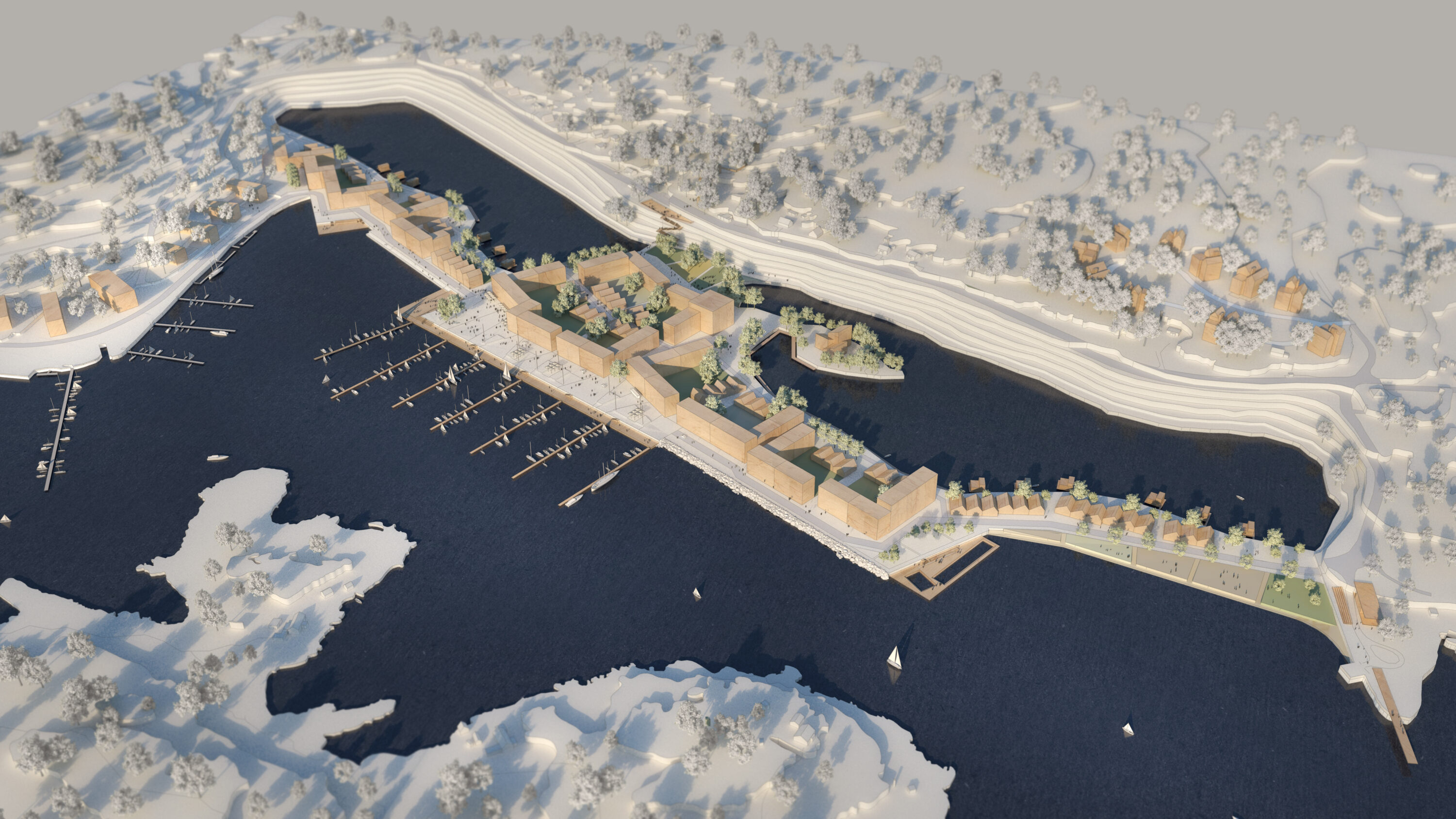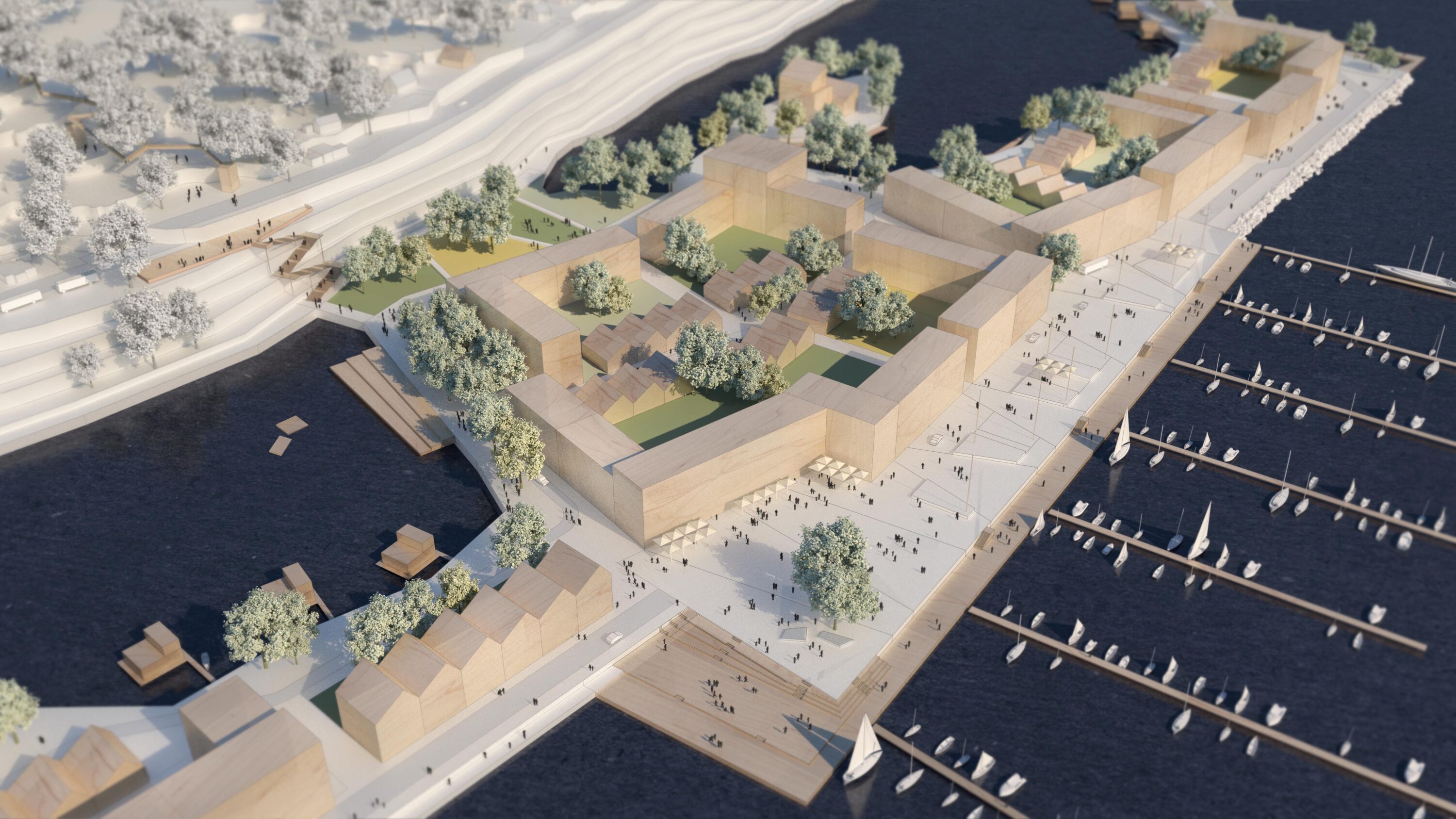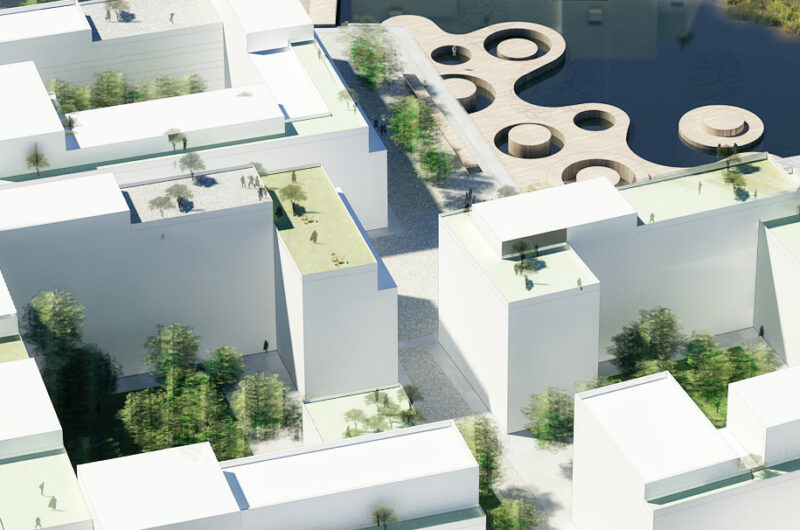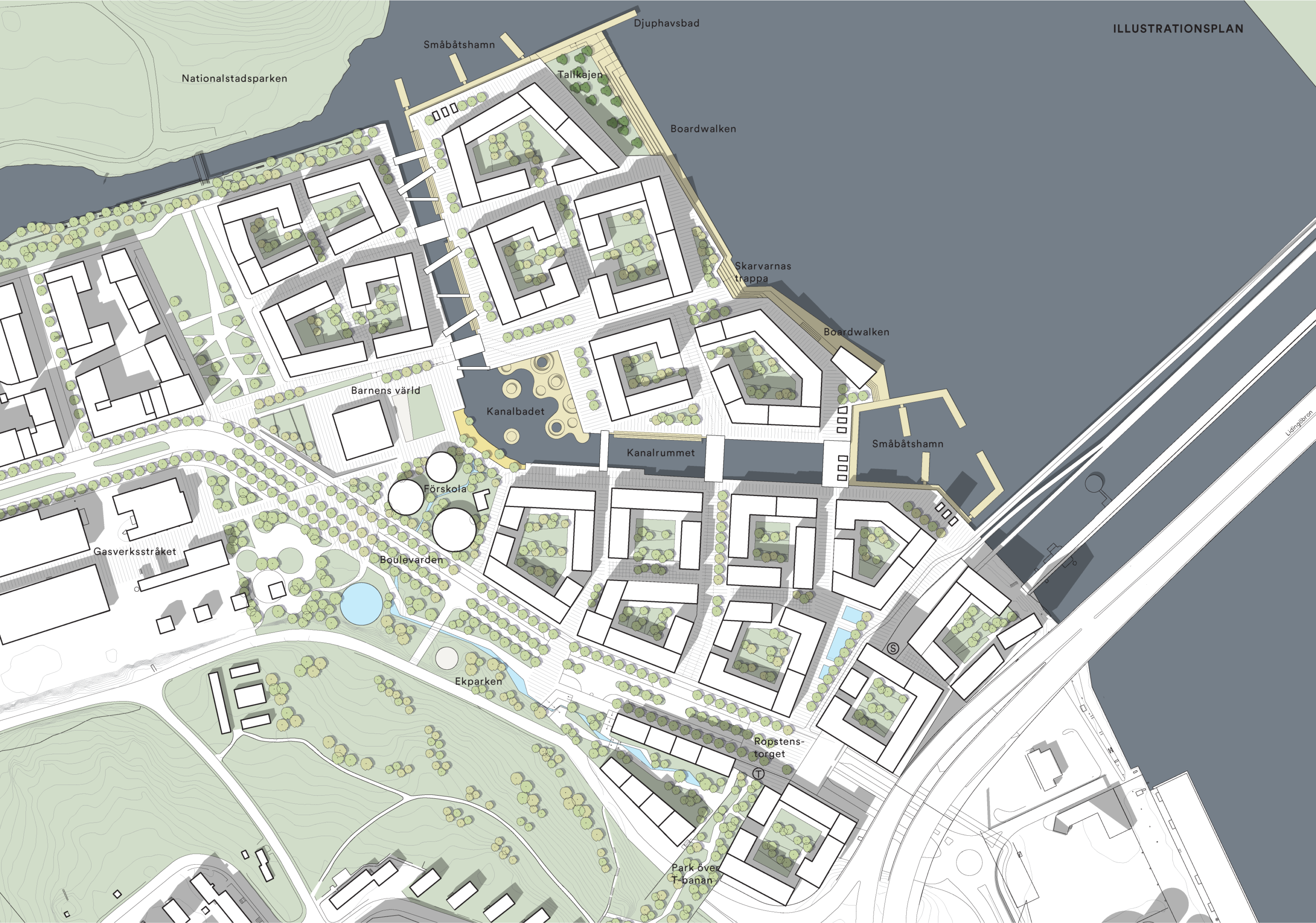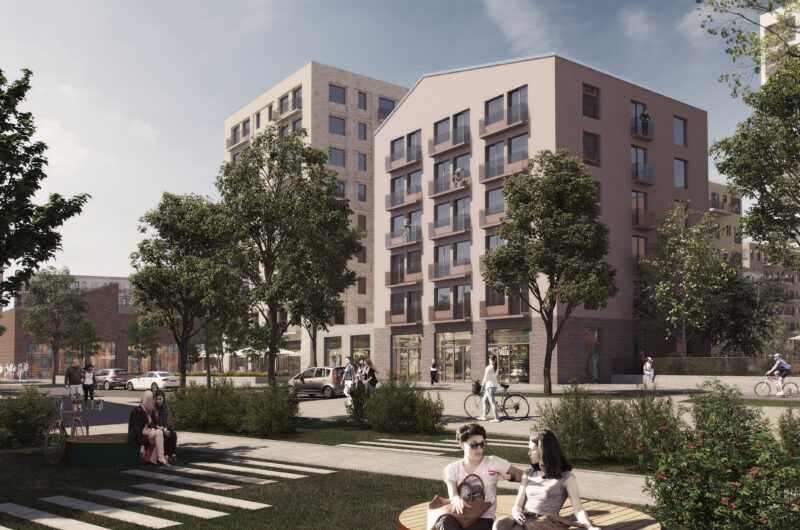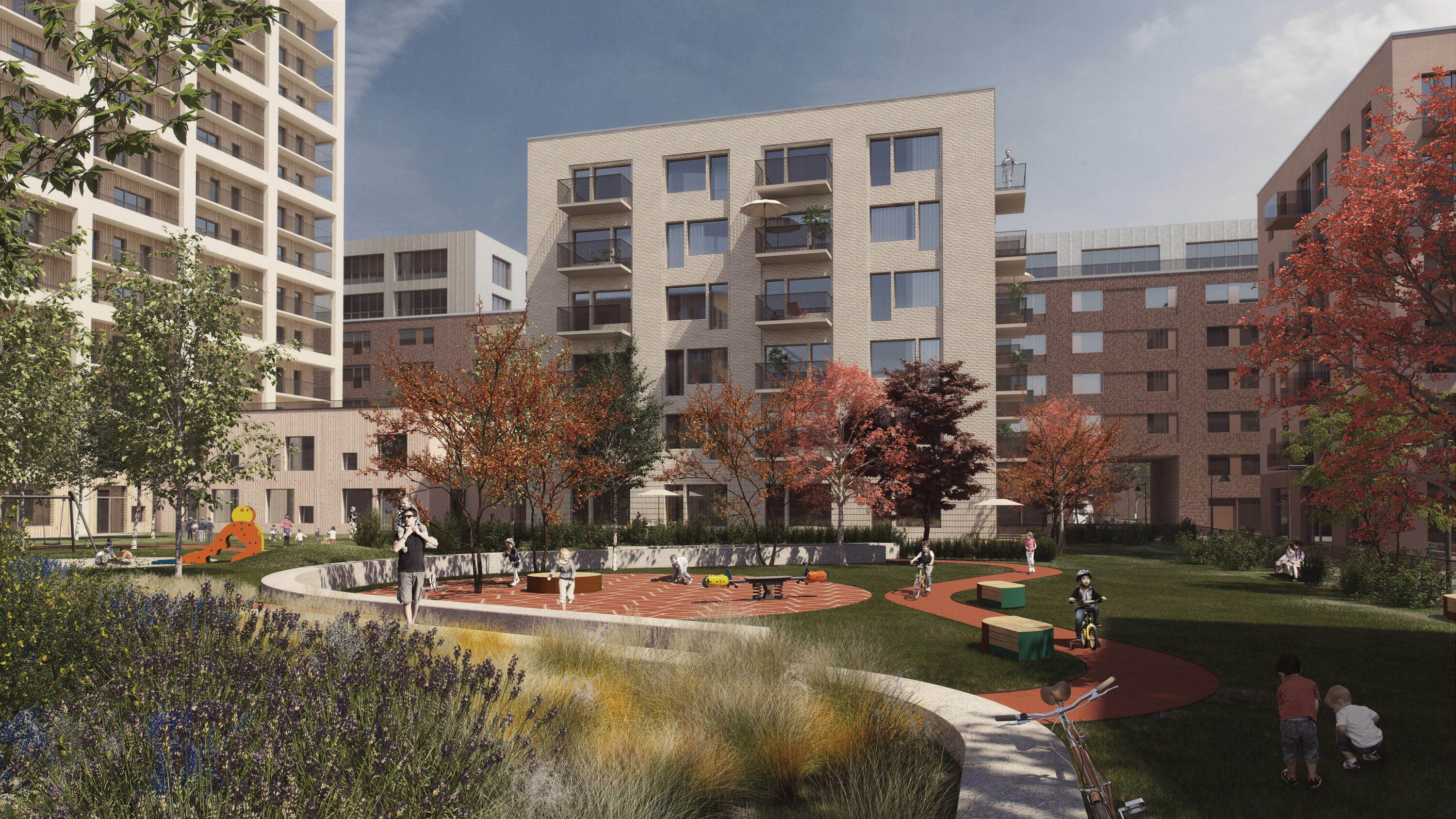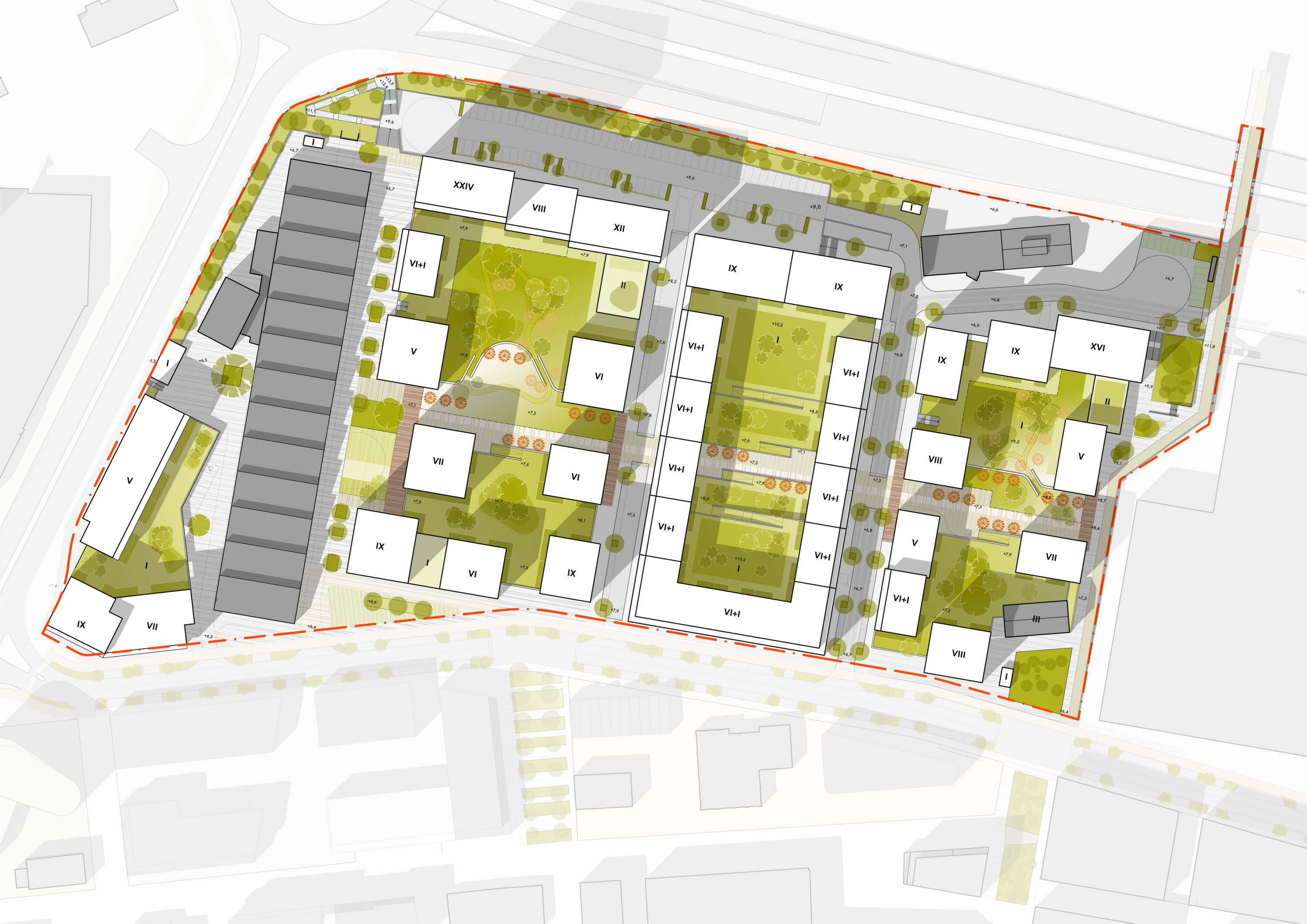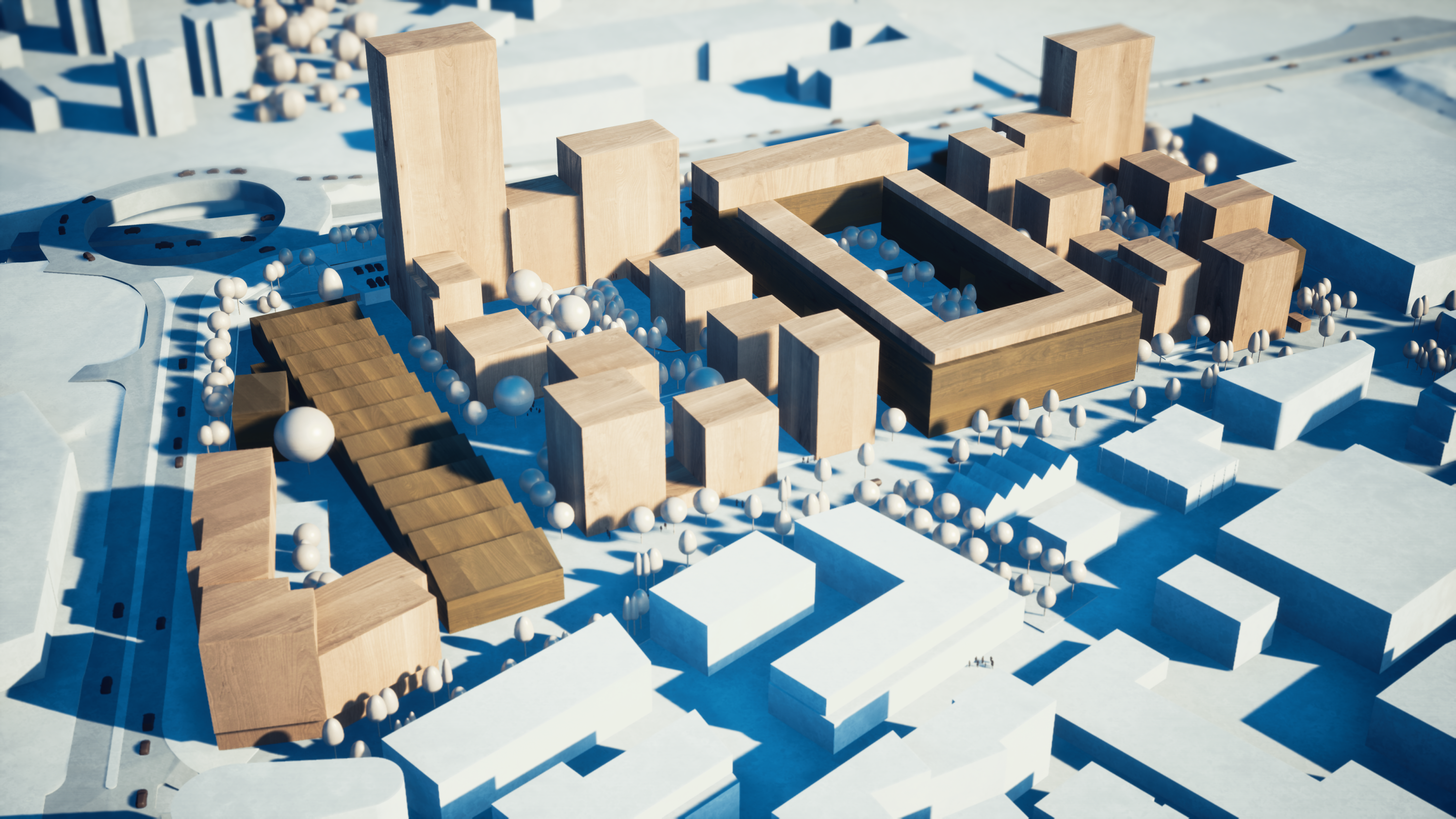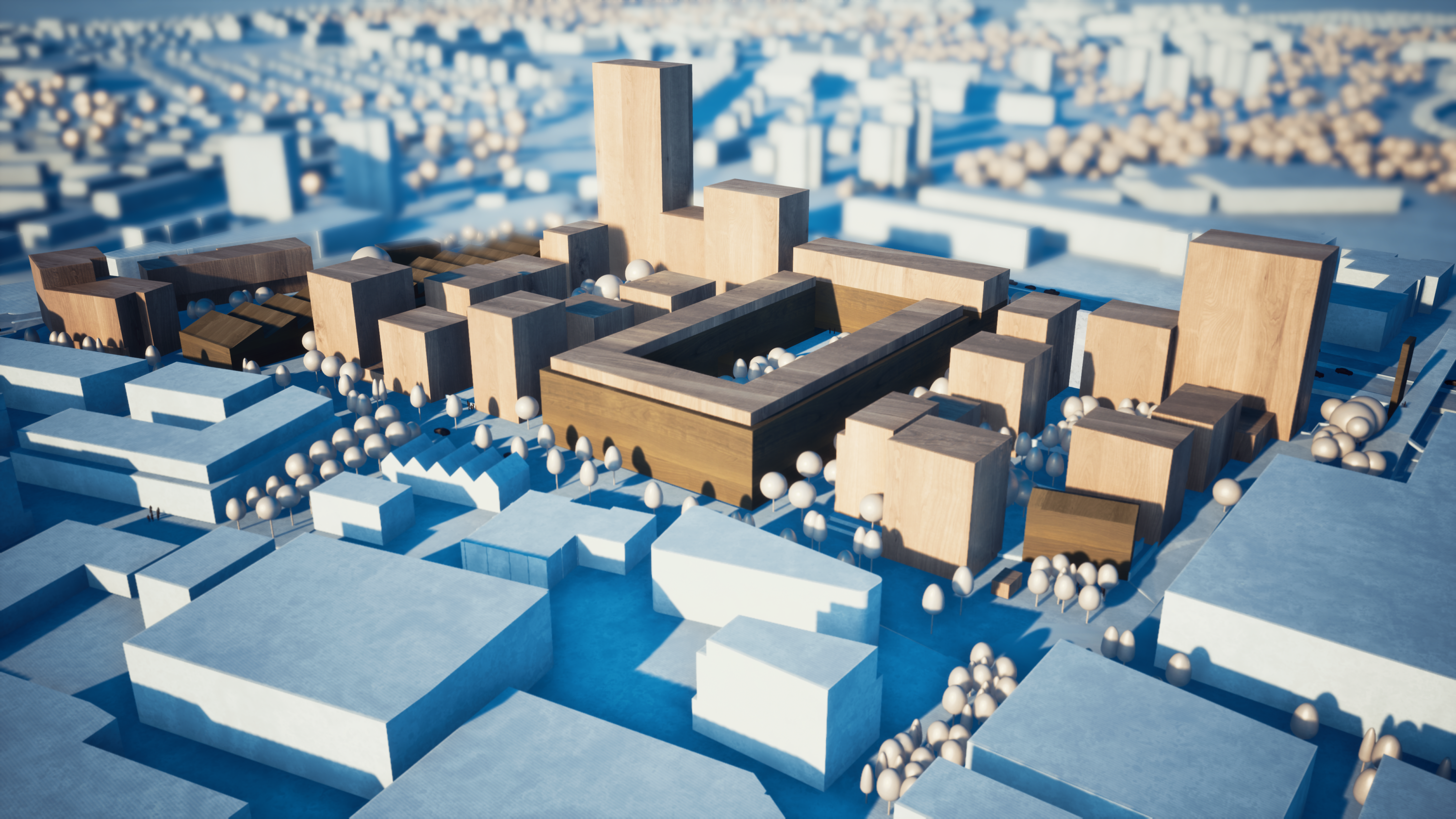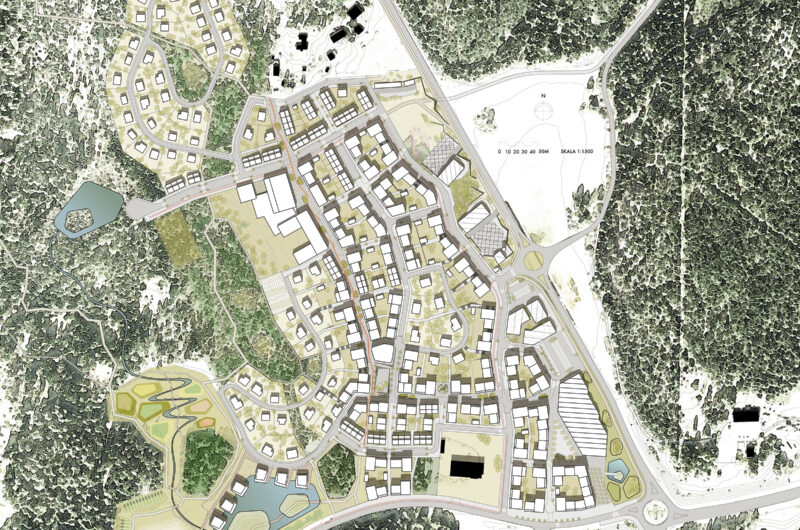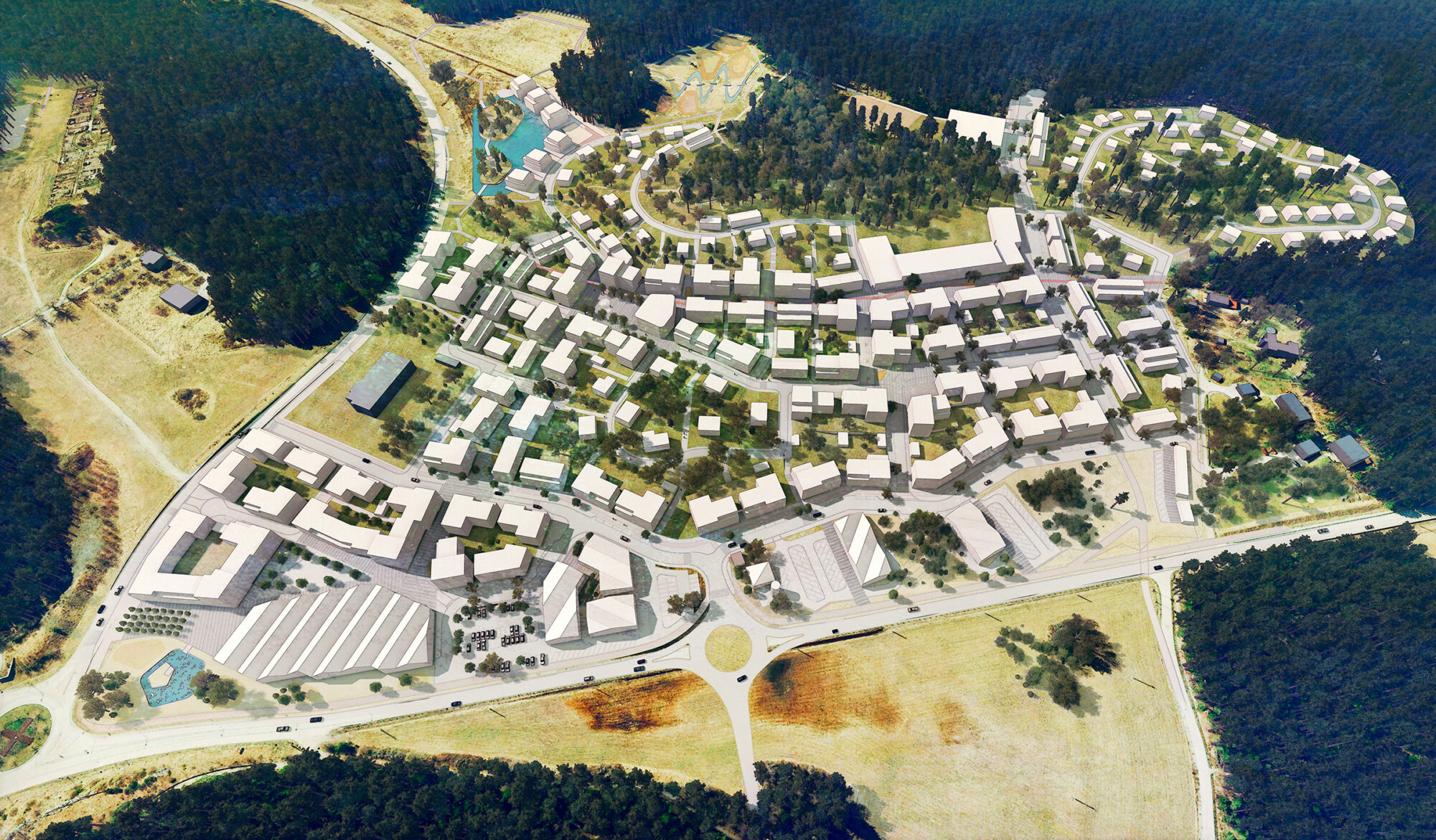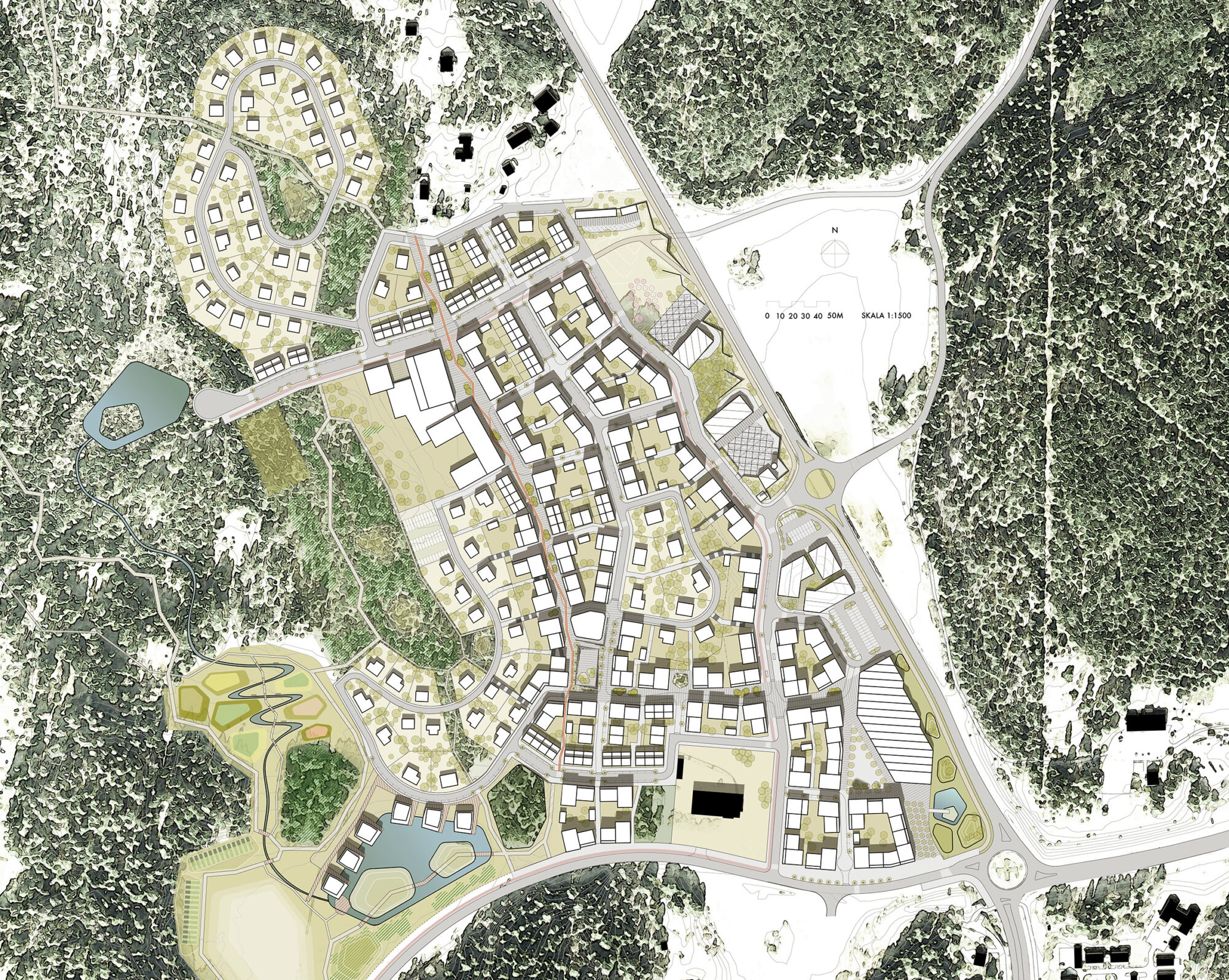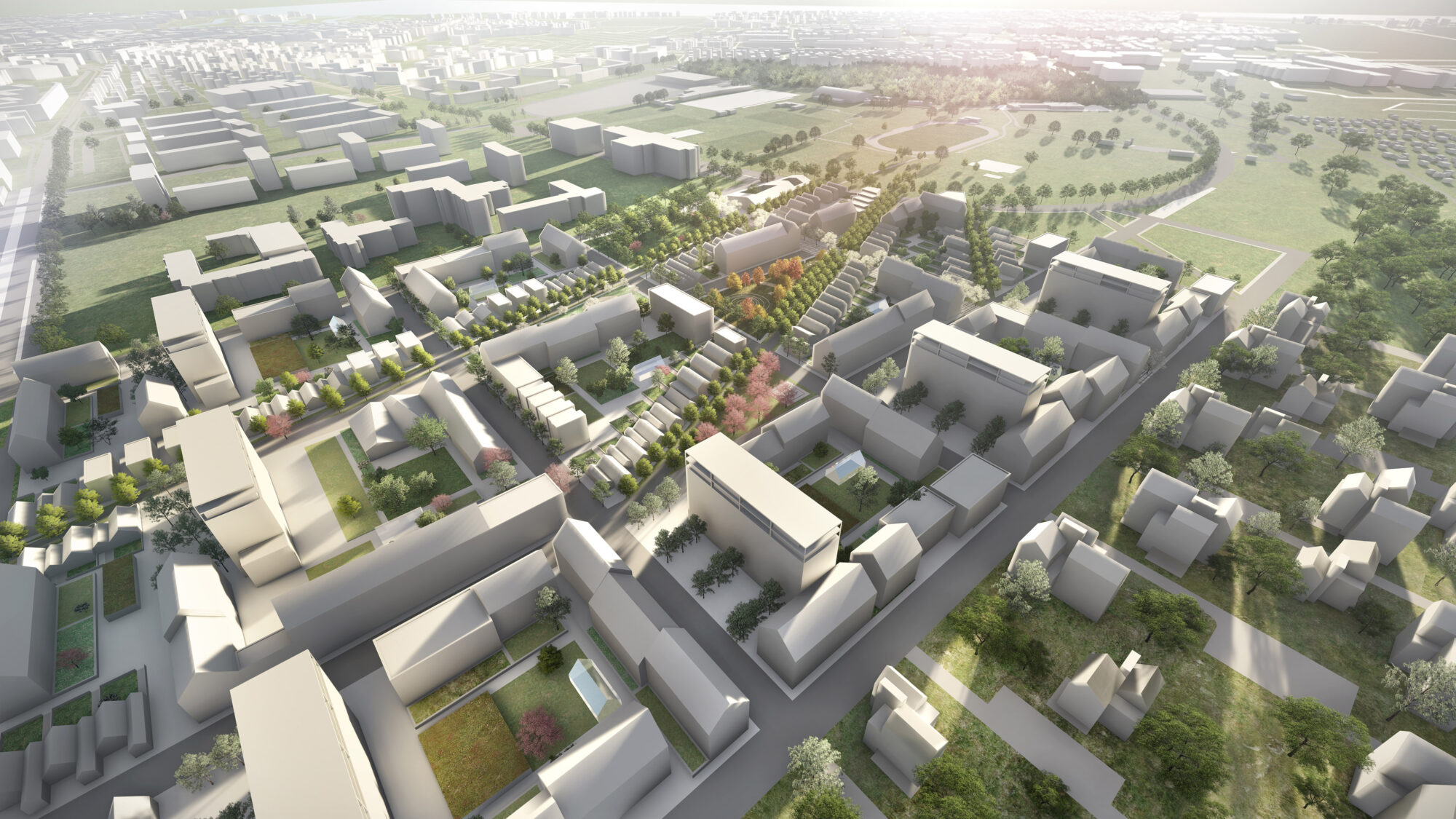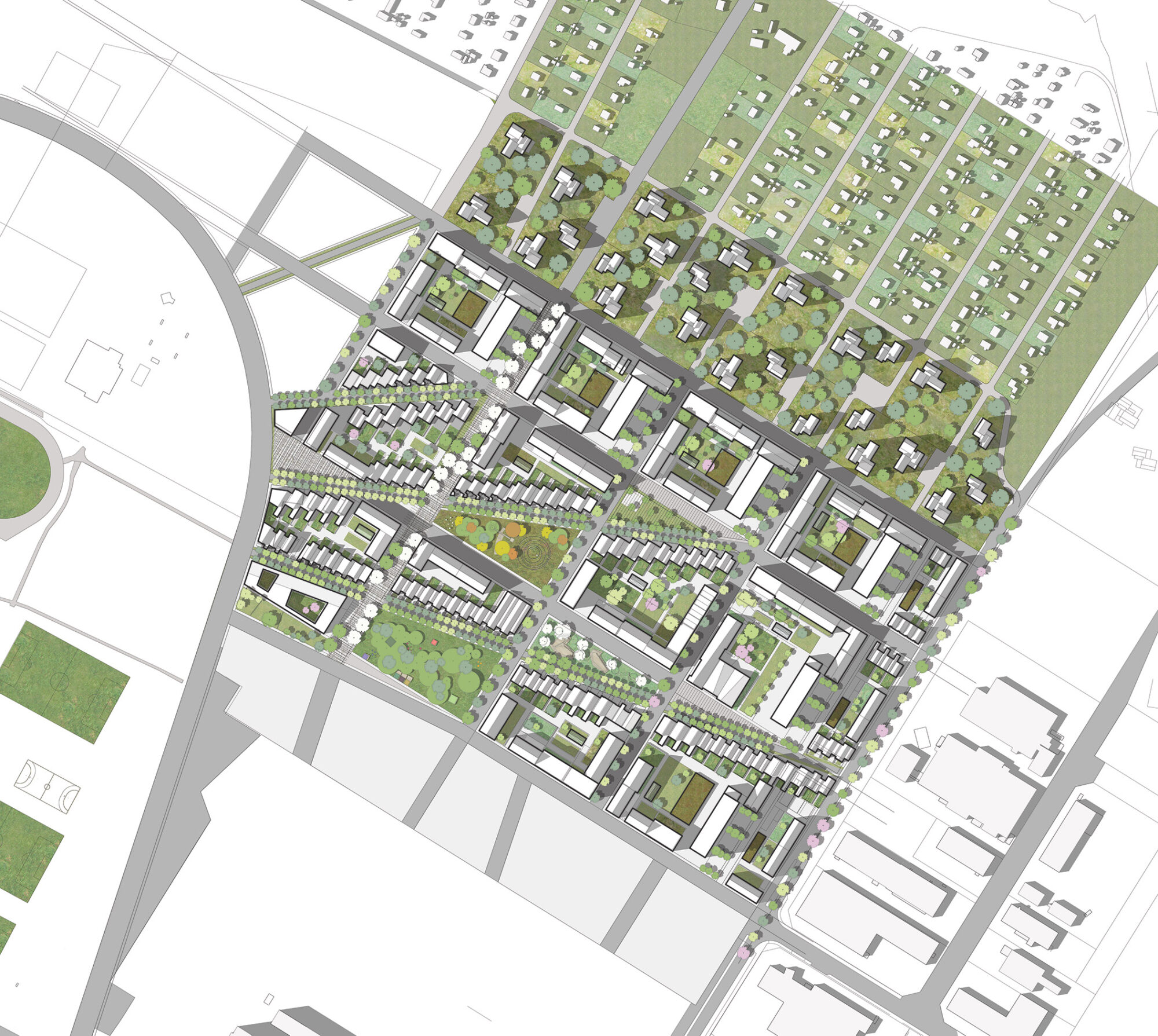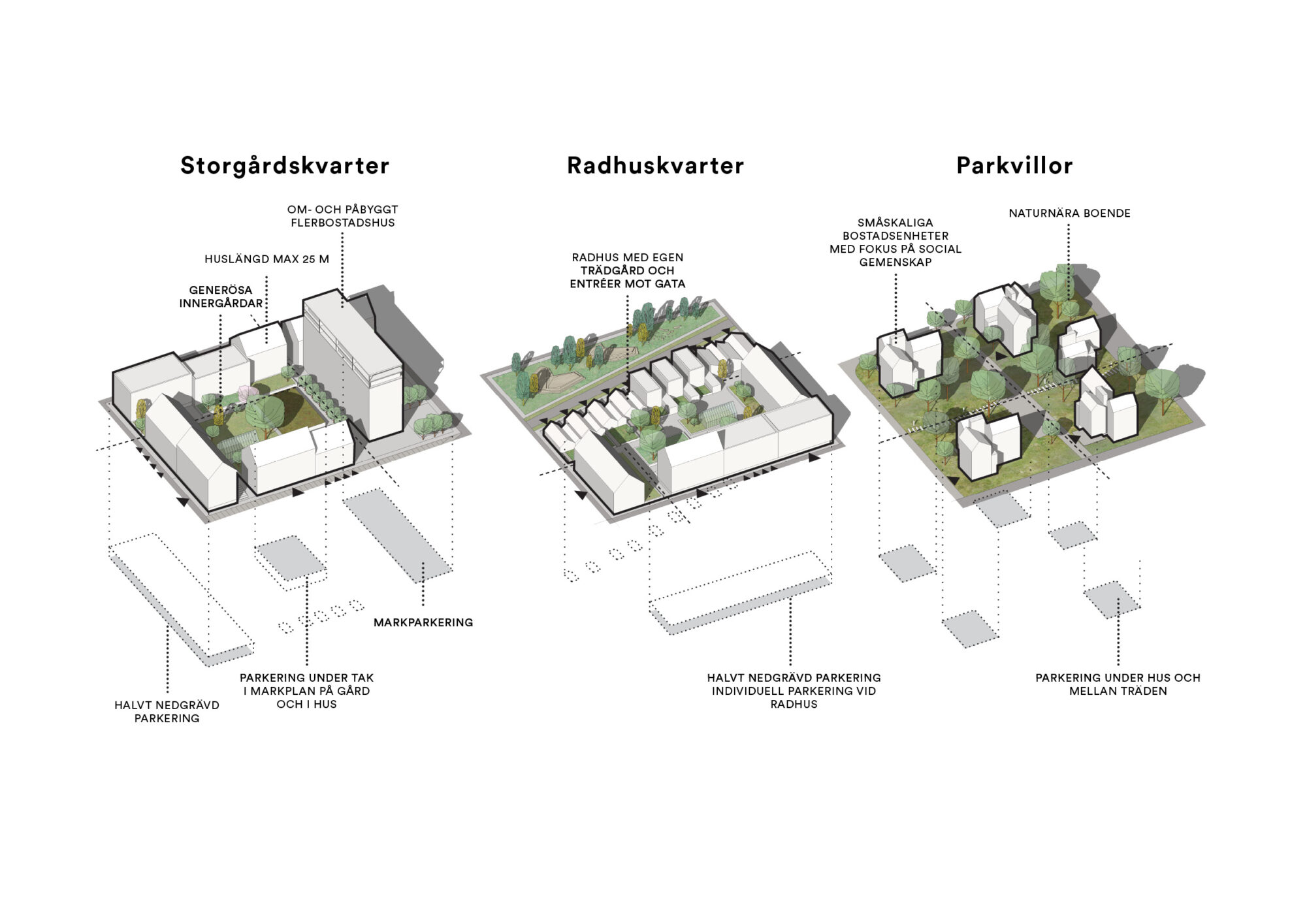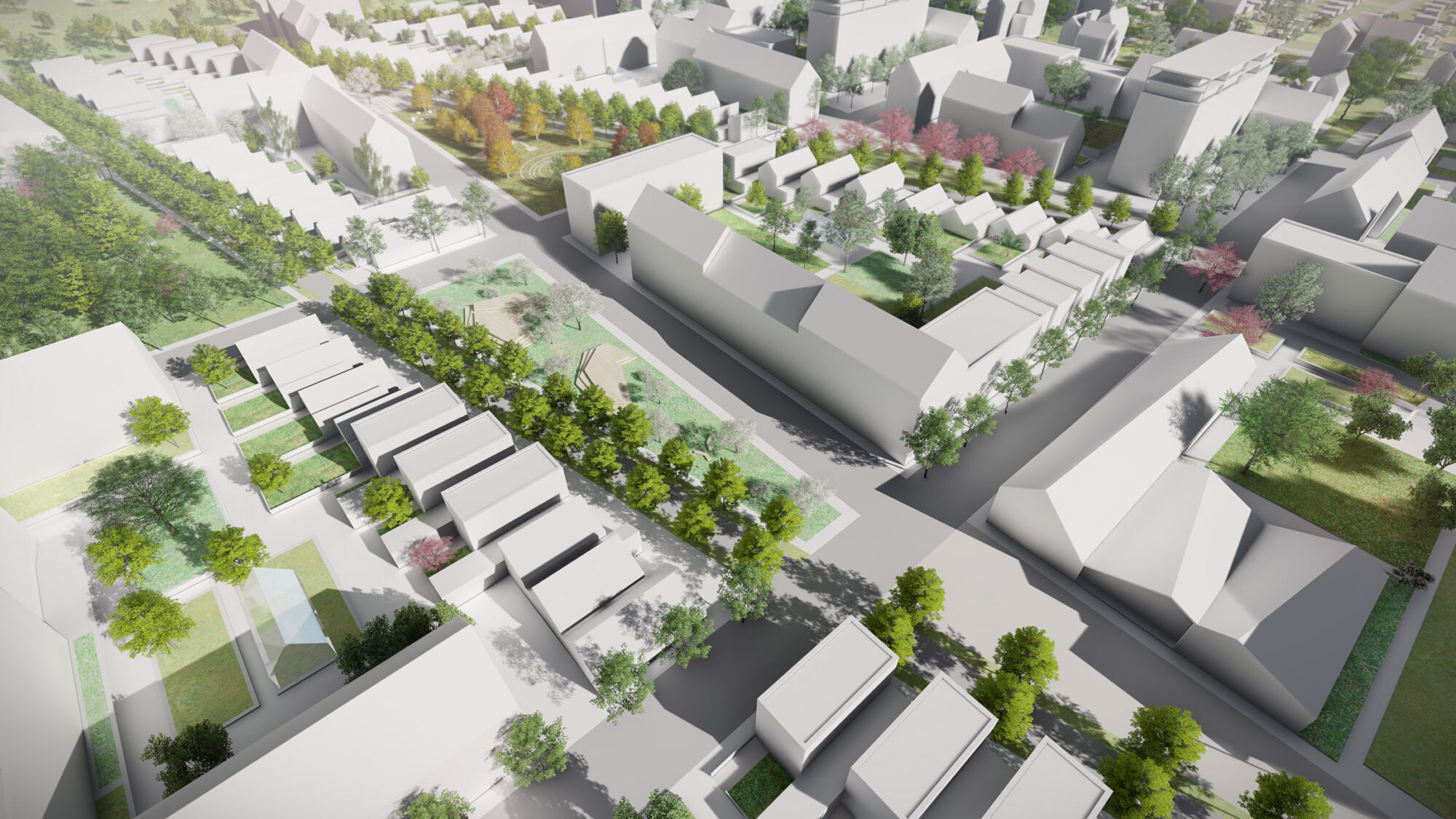Science Village Scandinavia
Science Village is located between the two research facilities MAX IV and ESS (European Spallation Source) in Brunnshög in northwest Lund. The purpose of the district is to maximize the benefits of the two research facilities for the region - and put Lund on the international map in life science and materials research. The area will be developed into an attractive neighborhood permeated by research, teaching, innovation and creative meetings between people.
FOJAB's assignment has been to take an integrated urban design approach for future stages of the development, based on how the site's core values can take shape in the built environment.
The urban development idea is to link the two research facilities MAX IV and ESS with urban areas where people meet in squares and streets. Establishing university premises in the area thus becomes part of an urban campus. A priority pedestrian route runs centrally through the area, linking the area's main public spaces and functions with ESS to the north and MAX IV to the south.
The high concentration of knowledge creates the conditions for local businesses to interact with the international research community. A creative environment is established for businesses, educational and research institutions that complements and supports the two research facilities and makes the research activities accessible to the public with exhibition halls and exhibitions.
In order to take advantage of the location and maximize the use of the agricultural land, the area has a high level of development. The height of buildings is lower along the central pedestrian route and at important recreational areas. This is also where a large part of the area's external functions are concentrated.
The Science Village is based on sustainability from different perspectives, which is reflected in the design. Sustainable mobility is prioritized. The outdoor environments are designed to cope with a more extreme climate with increased rainfall and the need for shade. A prioritization has already been developed for how trees should be planted so that they provide the greatest benefit in terms of climate and well-being. Innovative area-wide system solutions contribute to energy efficiency, local energy production and circular use of resources.
Jägersro
At Jägersro in Malmö, a new district will be built with room for 5000 homes, workplaces, shops, schools and preschools. FOJAB is preparing the structural plan for what will be the most sustainable district in the Öresund region.
Many Malmö residents have a connection to and memories of Jägersro. Several of the historical structures from the old racetrack are preserved, but are given a new content, thus helping to shape the identity and history of the new district. Jägerspark will be a healthy, urban neighborhood with historical elements in a modern style.
The structure plan adds several new values, routes and functions to eastern Malmö. The urban development concept focuses on three streets that connect the district with surrounding areas, and which meet in a large central park. An urban street becomes the commercial focal point of the district with shops, services, bazaars and flea markets. Urban villages with bustling alleys and greenery allow for meetings and local community.
Jägersro will be a climate netural neighborhood built to withstand both 100-year rainfall and an average temperature increase. Greenery on the doorstep encourages sustainable choices. Sharing of box bikes makes it easy to leave your car behind and bring goods from the delivery pool to yourself and your neighbor. The greenhouse can be combined with a study and work hub where it is easy to study or work from home and network across generations. The schools in the district are located next to the park or natural area to the east, providing attractive, quiet and safe environments.
Lövholmen
FOJAB works as a structural architect for the urban development area Lövholmen in the Liljeholmen district of Stockholm. In a project group with the City of Stockholm and in close collaboration with developers, property owners and various consulting groups, FOJAB is working to develop an urban structure for the culturally valuable industrial area.
With its older industrial environments, Lövholmen is a place with high cultural values that tells the story of the development of the industrial city of Stockholm. The plan proposal aims to highlight the groups of culturally interesting buildings that are preserved and create a framework around them in the form of new city blocks.
The added blocks together with the preserved buildings and the new public spaces form a whole that gives Lövholmen a strong identity of its own. The area will also interact with surrounding neighborhoods in scale and character and become a well-composed element in the city's new silhouette.
Lövholmen is currently largely closed to the public and an overall goal is to make this central place in Stockholm accessible. The design of places and paths therefore has as high a priority in the plan proposal as the buildings. A path runs through the district with a string of attractive small and large urban spaces. A large waterfront area is created with afternoon and evening sunshine, with a bathing jetty and space for various events. A quayside promenade runs along Liljeholmsviken, making it possible to walk along the Mälar shore all the way from Danvik to Vårby.
Our work with Lövholmen began in the fall of 2021 when a structure plan proposal was developed. In 2022, the structure plan was reworked in an iterative process that has included developers, property owners and various consulting groups. In the spring of 2023, the work on the plan proposal was deepened and documentation for consultation was produced.
Structure plan Ljungskogen
Carefully placed in nature, in a subdued color scale and with the sea as a neighbor. FOJAB has designed an addition to the existing building structure in Ljunghusen, Vellinge. The proposal provides a mixed development with different types of housing with a total of 100 homes.
A starting point has been to preserve the natural landscape character of the area. The new development consists of terraced houses, multi-family houses and single-family houses, which are placed with great consideration for existing vegetation and ground levels. Consideration has also been given to future sea level rise by placing the houses partly on pillars. Wooden facades connect with nature and the color scheme is dominated by muted earth tones such as grey, brown and black.
The five apartment buildings will have three floors and a recessed penthouse, in broken volumes that create variation in the facade and provide views in several directions. Like the neighboring award-winning Opushusen, also designed by FOJAB, the apartment buildings are built on columns that give the impression of floating above the pristine landscape. There is parking underneath the buildings. By raising the building on pillars, all apartments can enjoy the view, while cars do not dominate the street scene. The area adds new qualities.
Green wedges run between the houses, which help to let nature, the sea and light into the area, while allowing existing vegetation to be preserved. The feeling should be that nature surrounds the houses and wanders into the gardens and between the houses. The small houses, with their 1-2 floors, connect to the scale of the existing residential buildings in the east. The houses are provided with terraces that take up the differences in level in the terrain and have only natural land between them.
The townhouses can be defined as a raised atrium with a walled garden. The social, public part is on the ground floor and an upper floor with private rooms, all with views of the sea. The townhouses are arranged in groups of five along the main street to the south, with views of the forest wedges.
In the northeastern part of the area, inside the embankment at the edge of the forest, a playground with a natural character is built. In the south, a park is designed as a clearing in the forest with a pond and a larger grass area for activities. The park is surrounded by a slope with seating and made accessible by bridges over the pond.
WiCiD - Water In City Design
How can urban water be used as an innovative resource to reduce our carbon footprint, enhance biodiversity and create social value? WiCiD will explore this!
Climate change will affect society as a whole, with impacts on ecosystems and different sectors of society. We need to protect the built environment and key societal functions from heavy rainfall and increased amounts of stormwater.
In the Vinnova-funded research project WiCiD, we are curious about how water can simultaneously have a positive impact in the city from several aspects. How can stormwater and cloudburst solutions be chosen at a strategic level that also act as carbon sinks, contribute to increased resilience to extreme weather, create amenity values in the city for people and a good habitat for animals and nature?
Within the project, we develop a methodology for a goal-focused approach to be used from master planning to built projects. A digital decision-making tool is designed where different alternatives can be communicatively compared with each other and evaluated against the project-specific goals.
The focus is to address stormwater and rainfall issues from a holistic perspective. Which strategic solution creates the most added value for long-term sustainability? The methodology helps, for example, officials in municipal administrations and private project developers to make well-founded and informed decisions.
WiCiD stands for Water in City Design, solutions for wicked planning problems and is a Vinnova-supported research project. In the project, FOJAB collaborates with DHI Sverige AB, Zenta AB, Chalmers, Göteborgs stad, VA Syd, Lund municipality, Göteborgsregionens Kommunalförbund and Tyresö municipality.
Read also Let the water take its place!
New Station City
A completely new city district will take shape at the station in Karlshamn. The new station town will contain around 500 homes and FOJAB has drawn up an urban development program for the entire area.
With Pengaberget at its back and in a sunny southwest position right next to the railway station, the new district will emerge. In the design work, we have taken inspiration from the older buildings in the city center.
Karlshamn is largely a well-preserved grid city with beautiful environments. The physical cityscape is made up of straight, parallel streets that form blocks with clear interiors and exteriors and lovely green courtyards. In the work on the new station town, we have started from the definite hierarchy of the street space and have been careful to connect to the existing buildings in a respectful way.
500 homes and services
When the freight handling at the railway station moves, there is room for a completely new district. South of the current railway tracks, new blocks of housing, workplaces and services will emerge, from Stationsvägen in the south to Regeringsgatan in the north.
The site is centrally located but currently feels rather remote. The new district will connect the city more clearly. Around 500 homes are planned, ranging from terraced houses to various types of apartment buildings. It will be a district that can attract people with different needs and wishes regarding their housing.
The area will also have public activities that will contribute to revitalizing the district at all times of the day. The hope is that this will lead to the area becoming a safer place, as more people move around the area during the day and in the evening.
Sustainable, enjoyable and rooted in the city
In close cooperation with Karlshamn municipality, the Swedish Transport Administration and Blekingetrafiken, a new traffic solution has been developed and a major focus has been on creating a good exchange point for public transport and sustainable modes of transport. It should be easy for all travelers to switch between train and bus, and a commuter parking with easy access to the station is planned.
Karlshamn has a high ambition for the district. The new station town will not only be a sustainable and pleasant district, but also a place that is clearly rooted in Karlshamn's unique character and identity. Here, different interests are balanced and that is exactly what good urban planning should be about. The goal is clear: New Station City will be a district where both existing and new Karlshamn residents can thrive.
Detailed planning work will start in spring 2021 and is expected to take two years. The new station city will be developed gradually over a period of 5-15 years from the start of construction.
Movement factor
Rörelsefaktor is a tool that helps to highlight and integrate physical activity issues in urban planning and construction. It is based on existing research and knowledge and adds what has been missing. Rörelsefaktor takes a comprehensive approach to all types of movement and illustrates the factors in the built environment that affect opportunities for physical activity. The tool can be used at several scales, from overall plans to the design of a residential yard, or to analyze an existing environment.
The tool has been developed since 2019 by FOJAB and the Swedish Sports Confederation. Municipalities from all over the country, state authorities and private actors have participated in the work. Pilot versions have been tested over time until the current version is completed.
Rörelsefaktor is a process support that raises and clarifies issues of physical activity from different perspectives and is advantageously used to gather different competencies. It can be used by different roles in an organization, both public and private. For example, those who work with urban planning, traffic, green structure, sports facilities and schools. The work is best done in collaboration!
The tool consists of worksheets and is designed to address all different types of physical activity in one context: organized sport, self-organized sport, everyday activity and active transport. The four types of movement are evaluated from four perspectives: interaction, spaces and paths, proximity and functions. These are parameters that are important to monitor in order to increase opportunities for movement.
The work process is structured in four stages and is documented in turn using easy-to-use worksheets. Step 1 is about creating an overall picture of the current situation and objectives. Step 2 tests the movement factor for the area through scoring. Step 3 is about drawing conclusions from the summarized results. Step 4 summarizes the measures required to achieve the target image for the area.
Working in a structured way with movement also creates other added values in addition to those linked to physical activity, such as security, equality and equity, children's perspective, social perspective, sustainable transport, natural values, participation and collaboration.
"Movement factor is a way to activate people for good health and activate the city for a vibrant urban life!"
FOJAB and the Swedish Sports Confederation are happy to help you test the tool, get in touch and we'll tell you more.
Read more and access the worksheets here (PDF).
Movement factor - Introduction version 2.0
Movement factor - Worksheet
Stärnö Sjöstad
At the former diabase quarry on Stärnö, a peninsula southwest of central Karlshamn, FOJAB has been commissioned by Karlshamn municipality to develop proposals for how the area can be developed into a new and unique future district for the people of Karlshamn.
The diabase quarry, where, among other things, the facade stone for the Empire State Building in New York was quarried, has been closed for a few years and today there are large visible traces of the industry. The site is characterized by a 25 meter high rock wall, two deep holes after the quarrying and a magnificent view of the archipelago and the sea. The site's magnificent and unique conditions provided clear inspiration for FOJAB's urban development concept for Stärnö Sjöstad and created its very special character.
FOJAB proposes to develop the area with housing, a guest harbor, viewing and bathing areas and recreation that takes advantage of the area's character, location and views. For example, the depth of the water in the old quarries provides opportunities for deep-sea diving and the rock wall can be used for climbing. The proposal also includes plans for restaurants, trade and public activities.
The long narrow city plan clearly relates to its two different sides and water spaces. The sea is met by higher protective buildings of 3-5 floors together with clear quaysides, piers and public spaces. Along the inner water spaces, a small-scale environment with a green character is created with houseboats and terraced houses in 2-3 floors.
In Stärnö Sjöstad, the street spaces have been designed to prioritize pedestrians and cyclists, which are promoted by, among other things, crossing paths and low speeds. A proposed boat bus and bus line will also make it easy to choose sustainable public transport for the journey into Karlshamn.
Once the municipality decides how to develop the area, it will be built in stages.
Kolkajen, Stockholm Royal Seaport
As one of three architectural firms in parallel assignments in 2014, FOJAB produced an urban development proposal for Kolkajen - Hjorthagen's waterfront in Stockholm Royal Seaport. The procurement also included a framework agreement for the design of public environments in Stockholm Royal Seaport and work on formal detailed plans.
Norra Djurgårdsstaden is one of the largest urban development areas in Stockholm and northern Europe. The area will, in a sustainable and resource-efficient way, accommodate about 35,000 workplaces and about 12,000 new homes with associated services and infrastructure. The current phase, Kolkajen - Ropsten, is located between Hjorthagsberget and Lilla Värtan, next to the bridge to Lidingö. To the southwest is the Ropsten metro station.
The area is currently industrial land. The area contains the culturally and historically valuable Vattengasverket and a heat pump plant for energy production that will be preserved.
The parallel assignments investigated how Hjorthagen's future entrance and waterfront can be designed with a focus on public urban spaces and parks. The starting point was both overall objectives regarding transport, energy, cycles, buildings, greenery, lifestyles and activities, as well as the specific character and conditions of the site. The goal is a dense and mixed neighborhood with a strong identity and high urban design qualities. Not everyone will be able to afford to live here, but everyone will be able to spend time here and enjoy the social life and proximity to the water.
The work began with the parallel assignment and FOJAB was also awarded a framework agreement with the Development Office of the City of Stockholm for the work on Norra Djurgårdstaden. The work included producing a detailed plan, design program, and program and system documentation for street and play environments in the area. The street spaces are important links in the new district and will be designed with a focus on stormwater, greenery and quality of life. On the waterfront, we design a large playground with a natural character where lush trees and undulating wooden structures create a stimulating play environment.
Kopparlunden
Right next to Västerås city center is Kopparlunden, a large business area with more than a hundred years of history that is of national interest for the cultural environment. On the initiative of the City of Västerås, the area is being transformed into a mixed-use city and FOJAB is working on the northern detailed plan on behalf of the property owners. The planning work is run as a so-called developer-driven plan, which means that FOJAB, in addition to preparing the basis for the detailed plan, also prepares planning documents and coordinates investigations.
Kopparlunden will be a district with a dense and mixed urban development, where existing buildings and its overall streets and places will form the base that fills the district with a viable and mixed content. The historic industrial environment is the basis for the area's identity and a quality that is utilized when the area is developed. Existing buildings are adapted to new functions and new buildings are added without losing the area's identity and character.
The area is planned with a number of city blocks that are divided into open and closed blocks to reflect the land that was developed or undeveloped during previous land use on the site. Active ground floors with shops face the main street in the south and the new north-south pedestrian street, while the other blocks are given their urban character through well-designed entrances to the street and houses in street life around private courtyards. There are also plans for two preschools with generous open spaces adjacent to green paths that contribute to ecosystem services and quality of life for residents and workers in the area.
Sigtuna Stadsängar
FOJAB is developing a new neighborhood with up to 1,000 homes in the Sigtuna urban area. The work consists of documentation for the detailed plan and follow-up to the implementation phase.
Sigtuna Stadsängar is an addition to Sweden's oldest city, which has left its mark on the design of the new district. The district is given a unique character reminiscent of the scale and spatial richness found in old Sigtuna. The district is also planned with high ecological and social sustainability goals.
Even though the planning of the new district takes place on previously undeveloped land, the project is based on Sigtuna's historical building structures and the qualities of the site. An urban environment is created that is unique and site-specific. The structure of the new district is based on the scale, character and property division we can see in historic Sigtuna and reinterprets it for today's requirements and wishes. Spatial experience and the scale and variety of urban spaces have been themes that have been continuously worked on in the process. While the structure, scale and urban spaces are reminiscent of historic Sigtuna, the aim is not to create a pastiche. The district should function and be designed according to today's requirements and the architecture is proposed to be contemporary, preferably forward-looking. The ambition is to create a sustainable city.
A number of sustainable solutions are included in the district, such as open stormwater management at district level with "rain gardens" in the street environment. A unique local heating system is planned with, among other things, 1000 square meters of solar collectors where 80 % of heat and hot water comes from solar energy. Both local and global projects for social sustainability are included in the development of the district and in the land allocation of the various blocks.
Seasonal parks
FOJAB's vision proposal shows the way in the ongoing work with the area Koppargården, Karlslund in Landskrona. The goal is to achieve a denser, more varied development and new attractive spaces, while preserving a large part of today's apartments and streets.
The city of Landskrona sees great opportunities for the Karlslund district in northern Landskrona and is now, in cooperation with the property owners, taking a comprehensive approach to the development of the area. The goal is to improve the environment in the area and develop an attractive residential area in the growing city. In a parallel assignment for the Koppargården sub-area with Landskronahem as the client, FOJAB has developed an early vision for the area.
The seasonal parks are a cross between a square and a park. They are intended to complement Karlslund's generous green spaces and sports facilities and help develop the area's identity. The vision includes 1600 homes, including the existing ones, as well as two new preschools. The new housing consists of a mix of apartment buildings in an open block structure and terraced houses. New, diagonal streets lead into the recreational area. A consistent idea is that the area should be easy to navigate and that residents should always be close to a park or other meeting place.

